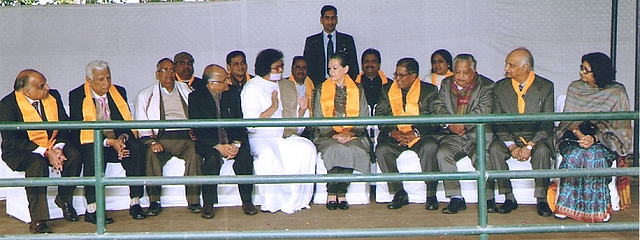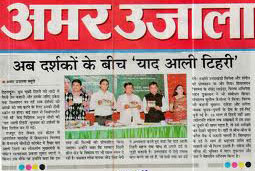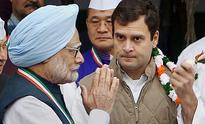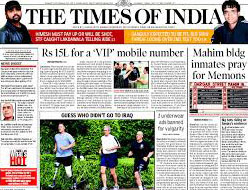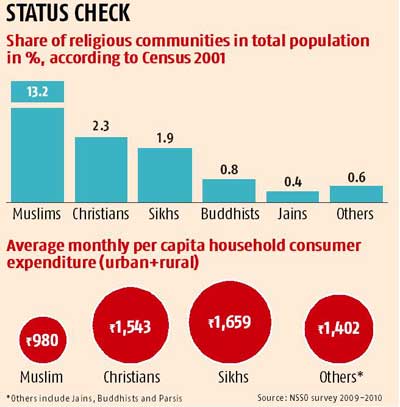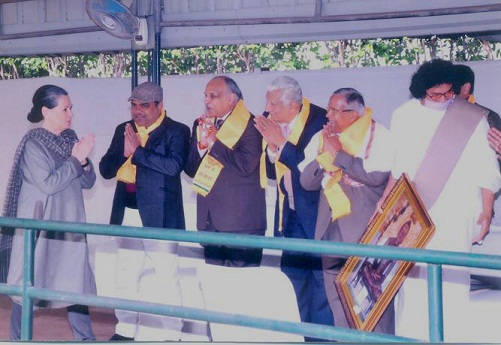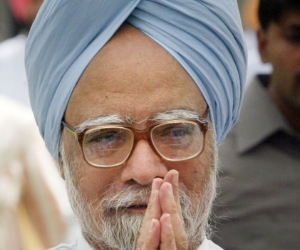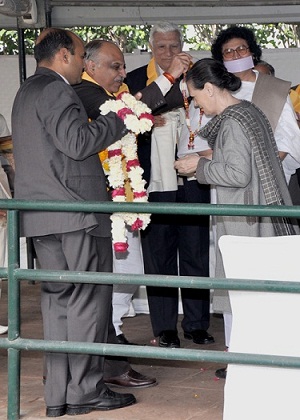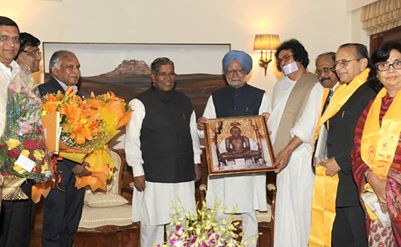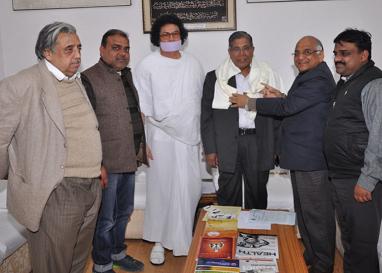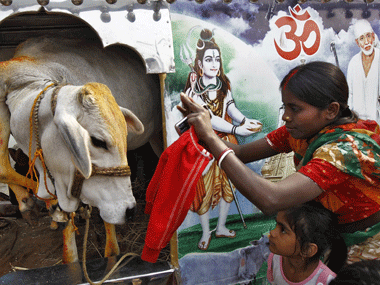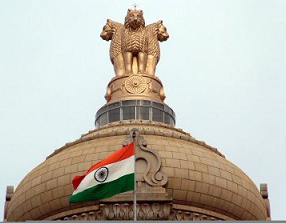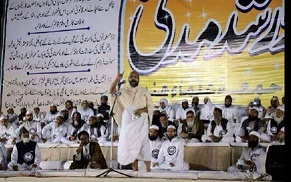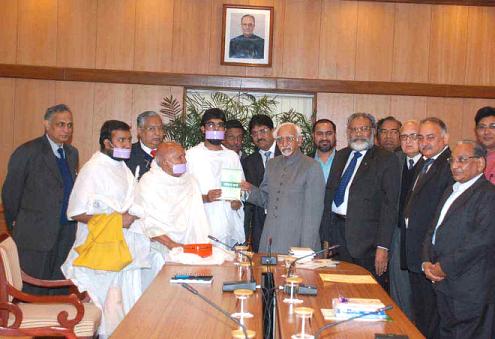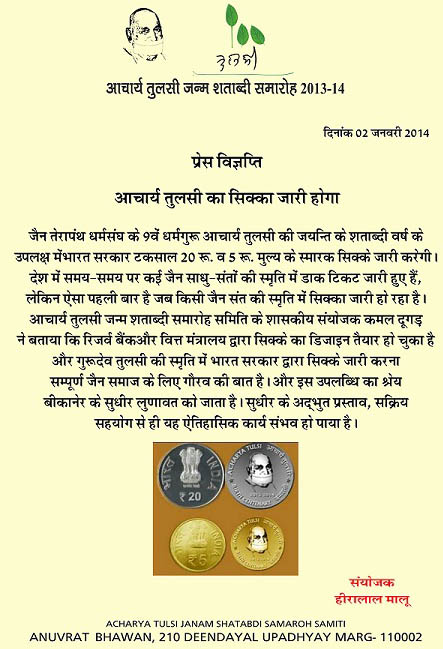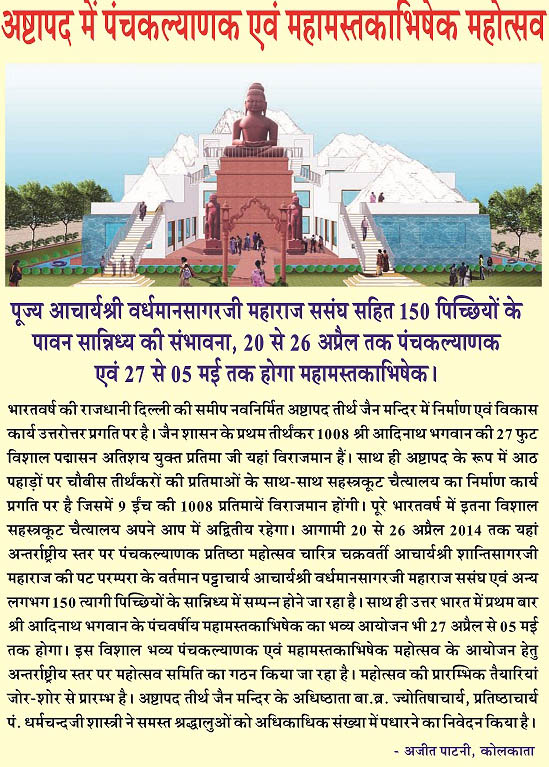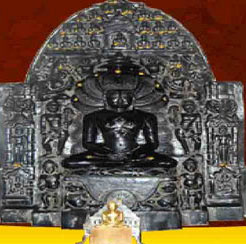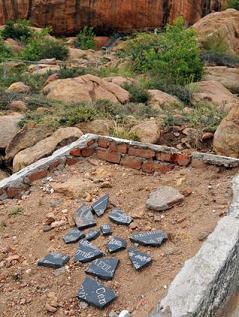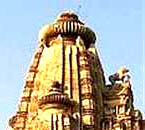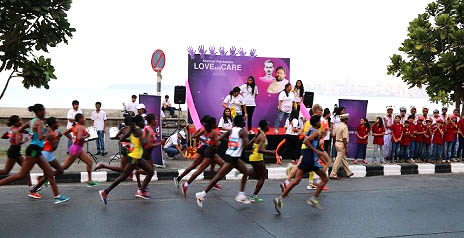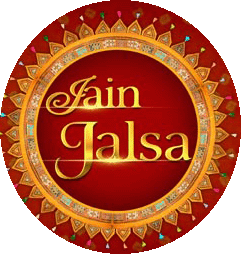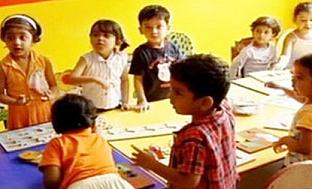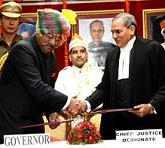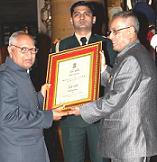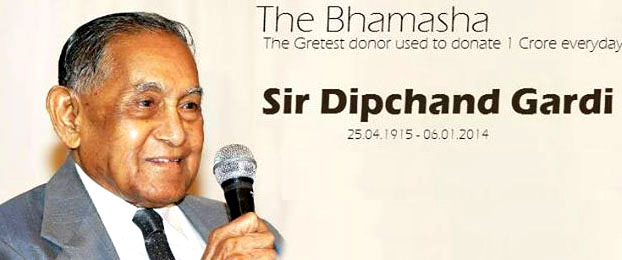THIS ISSUE OF AHIMSA TIMES DEDICATED TO JAIN MINORITY ISSUE
Trustees, Editors & Patrons of Ahimsa Foundation & Ahimsa Times Expresses their
Gratefulness towards Indian Cabinet for Granting Minority Status to Jains at National Level.
While paying homage, we also remember Late Sri Bal Patil and thank him for his arduous
efforts on behalf of Jain Community on this subject. Several Individuals and Institutions have
also ad infinitum worked on this issue.
The list is long & any omission will be indefensible,
therefore all the individual names are not referred.
However it will also be awfully iniquitous not to cite the names of Cabinet Minister Kapil Sibal, K. Rehman Khan
and Pradeep Jain, Lokesh Muni, Chakresh Jain, Supreme Court Advocate Sushil Jain, Sahu R. P. Jain
and U. Sudhir Lodha who acted and reacted immaculately to finish the unfinished agenda of the Late Shri Bal Patil
|
Jain Community felicitated on 23rd January, 2014 Smt. Sonia Gandhi at here residence for supporting resolution about granting Minority Status.
Photograph seating form Left to Right [ Front Row] Shri Anil Jain, President - Ahimsa Foundation, President Digamber Mahasabha Shri Nirmal Sethi, Chairman Jain Conference Shri Ananad Prakash Jain, Shri Ramesh Jain, Shri Lokesh Muniji, Mrs. Sonia Gandhi, Cabinet Minister for Minority Affairs Shri K. Rahman Khan, President of Delhi Jain Samaj Shri Chakresh Jain, Shri D.K. Jain from Jain International Organisation, Smt. Kenu.
NOTE ON MINORITY RIGHTS
There is a confusion in Jain Community with regard to minority rights. Whenever a demand is raised by Jain community for the said rights a confusion is created among Jains as if we are asking reservation like Scheduled Castes and Scheduled Tribes. At the outset I may clarify that by asking minority rights under the Constitution does not mean that the Jains are asking any reservation given to the Scheduled Castes and Scheduled Tribes communities. In this respect I may submit that in a democratic country normally majority rule of majority religion prevails. To protect the non-followers of majority religion, the Constitution makers have given some protection and conferred special rights under Article 30 of the Constitution of India. In Indian Constitution right to equality, religion, freedom of speech, residence, etc. etc. are fully protected. However, there are certain other rights such as right to administer its own culture, belief and right to education. No society can develop without education. The Constitution makers have recognized right to establish and administer educational institution under Article 30 of the Constitution of India.
|
The object and importance of minority rights is well considered, explained and recognized by Eleven Judges Bench of the Hon’ble Supreme Court of India in the matter of the T. M. A. Pai Foundation vs. State of Karnataka as under:
158.The one billion population of India consists of six main ethnic groups and fifty-two major tribes; six major religions and 6,400 castes and sub-castes; eighteen major languages and 1,600 minor languages and dialects. The essence of secularism in India can best be depicted if a relief map of India is made in mosaic, where the aforesaid one billion people are the small pieces of marble that go into the making of a map. Each person, whatever his/her language, caste, religion has his/her individual identity, which has to be preserved, so that when pieced together it goes to form a depiction with the different geographical features of India. These small pieces of marble, in the form of human beings, which may individually be dissimilar to each other, when placed together in a systematic manner, produce the beautiful map of India. Each piece, like a citizen of India, plays an important part in making of the whole. The variations of the colours as well as different shades of the same colour in a map is the result of these small pieces of different shades and colours of marble, but even when one small piece of marble is removed, the whole map of India would be scarred, and the beauty would be lost.
159. Each of the people of India has an important place in the formation of the nation. Each piece has to retain its own colour. By itself, it may be an insignificant stone, but when placed in a proper manner, goes into the making of a full picture of India in all its different colours and hues.
160. A citizen of India stands in a similar position. The Constitution recognizes the differences among the people of India, but it gives equal importance to each of them, their differences notwithstanding, for only then can there be a unified secular nation. Recognizing the need for the preservation and retention of different pieces that go into the making of a whole nation, the Constitution, while maintaining, inter alia, the basic principle of equality, contains adequate provisions that ensure the preservation of these different pieces.
161. The essence of secularism in India is the recognition and preservation of the different types of people, with diverse languages and different beliefs, and placing them together so as to form a whole and united India. Articles 29 and 30 do not more than seek to preserve the differences that exist, and at the same time, unite the people to form one strong nation.”
Rights under Constitution of India: The minority rights are recognized under Article 30 of the Constitution of India, which gives right to the minority to establish and administer its own educational institution, reads as under:
“30. (1) All minorities, whether based on religion or language, shall have the right to establish and administer educational institutions of their choice.”
(1A) In making any law providing for the compulsory acquisition of any property of an educational institution established and administered by a minority, referred to in clause (1), the State shall ensure that the amount fixed by or determined under such law for the acquisition of such property is such as would not restrict or abrogate the right guaranteed under that clause.
(2) The State shall not, in granting aid to educational institutions, discriminate against any educational institution on the ground that it is under the management of a minority, whether based on religion or language.
Recently, while amending Article 15 of the Constitution of India, the Constitution makers have excluded the rights conferred on the minority education institutions referred to in Clause 1 of Article 30 of Constitution of India. The proviso to Article 15(5) of the Constitution of India reads –
“15(5) Nothing in this article or in sub-clause (g) of clause (1) of article 19 shall prevent the State from making any special provision, by law, for the advancement of any socially and educationally backward classes of citizens or for the Scheduled Castes or the Scheduled Tribes in so far as such special provisions related to their admission to educational institutions including private educational institutions, whether aided o unaided by the State, other than the minority educational institutions referred to in clause (1) of article 30.”
On account of aforesaid rights conferred on the minorities, any minority community can run their institutions without any interference by the government. They can appoint their own teachers, without any interference by Government and can give preference to own community teachers without any reservation to SC/ST or other backward classes. They can give preference and admit their own community students without any reservation for Scheduled Castes, Scheduled Tribes and other backward classes. This right is an important right in a context where our community to improve education amongst children can establish our own educational institutions in any subject. Right to establish or administer education includes right to teach our own religion in the said institution along with other normal and ordinary or professional subjects. Education plays a very important role for development of any society. I have seen in the past where despite merits large number of our children are not able to get their admission in the schools and colleges on account of reservation policies. This results in frustration in our children. If we are not treated as minority then none of the above benefit is available.
Rights under National Commission for Minorities Act, 1992
In addition to above, constitutional rights under Article 30 and 15 of the Constitution of India the Government of India has enacted National Commission for Minorities Act 1992 with the following objects and reasons:-
“The Minorities Commission was set up in January 1978 for providing an institutional arrangement for evaluating the safeguards provided in the Constitution for protection of the minorities and to make recommendations for ensuring implementation of the safeguards and the laws.
2. The Minorities Commission with statutory status would infuse confidence among the minorities about the working and effectiveness of the Commission. It would also carry more weight with the State Governments/Union territory Administration and the Ministries/Departments and other organizations of the Central Government.
3. It has, therefore, been decided to give statutory status to the Minorities Commission by the proposed legislation.
4. The National Commission for Minorities will consist of a Chairperson and six Members.
5. The main task of the Commission shall be to evaluate the progress of the development of minorities, monitor the working of the safeguards provided in the Constitution for the protection of the interests of minorities and in laws enacted by the Central Government or State Governments, besides looking into the specific complaints regarding deprivation of rights and safeguards of the minorities. It shall cause studies, research and analysis to be undertaken on the issues relating to socio-economic and educational development of the minorities and make recommendations for the effective implementation of the safeguards for the protection of interests of minorities by the Central Government or State Governments. It may also suggest appropriate measures in respect of any minority to be undertaken by the Central Government or State Governments.
6. The Bill seeks to achieve the aforesaid objects.”
Under Section 9 of the said Act functions of the Commission have been defined. Section 9 of the National Commission for Minorities Act, 1992 reads as under:
(1) The Commission shall perform all or any of the following functions, namely:-
(a) evaluate the progress of the development of Minorities under the Union and States;
(b) monitor the working of the safeguards provided in the Constitution and in laws enacted by Parliament and the State Legislatures;
(c) make recommendations for the effective implementation of safeguards for the protection of the interests of Minorities by the Central Government or the State Governments;
(d) look into specific complaints regarding deprivation of rights and safeguards of the Minorities and take up such matters with the appropriate authorities;
(e) cause studies to be undertaken into problems arising out of any discrimination against Minorities and recommend measures for their removal;
(f) conduct studies, research and analysis on the issues relating to socio-economic and educational development of Minorities;
(g) suggest appropriate measures in respect of any Minority to be undertaken by the Central Government or the State Governments;.
(h) make periodical or special reports to the Central Government on any matter pertaining to Minorities and in particular the difficulties confronted by them;
(i) any other matter which may be referred to it by the Central Government;
(2) The Central Government shall cause the recommendations referred to in clause (c) of sub-section (1) to be laid before each House of Parliament along with a memorandum explaining the action taken or proposed to be taken on the recommendations relating to the Union and the reasons for the non-acceptance, if any, of any of such recommendations.
(3) Where any recommendation referred to in clause (c) of sub-section (1) or any part thereof is such with which any State Government is concerned, the Commission shall forward a copy of such recommendation or part to such State Government who shall cause it to be laid before the Legislature of the State along with a memorandum explaining the action taken or proposed to be taken on the recommendations relating to the State and the reasons for the non-acceptance, if any, of any of such recommendation or part.
(4) The Commission shall, while performing any of the functions mentioned in sub-clauses (a), (b) and (d) of sub-section (1), have all the powers of a civil court trying a suit and, in particular, in respect of the following matters, namely:-
(a) summoning and enforcing the attendance of any person from any part of India and examining him on oath;
(b) requiring the discovery and production of any document;
(c) receiving evidence of affidavits;
(d) requisitioning any public record or copy thereof from any court or office;
(e) issuing commissions for the examination of witnesses and documents; and
(f) any other matter which may be prescribed;”
In view of the specific functions of the National Minorities Commission, the Minorities Commission, both Central and States, undertake studies with regard to complaints regarding deprivation of rights and safeguards of minorities. The Minority Commission also study and make researches with regard to socio-economic conditions and educational development of minorities. The functions of the national Minorities Commission as defined in Section 9 are very wide and are beneficial to our community. At present various schemes with regard to development of minorities, both socially and economically are being undertaken by the Central Government and the State Governments which will be most beneficial for the development of minority community.
Article 27 of United Nations Speaks about Minority Rights
Minority rights are recognized by United Nations. Article 27 of the International Covenant on Civil and Political Rights recognizes rights of persons belonging to ethnic, religious and linguistic minorities. The United nations inspired by the said Article 27 and considering and emphasizing that the constant promotion and realization of rights of persons belonging to national as ethnic religious and linguistic minorities as an integral part of the development of society as a whole and within a democratic framework based on the rule of law, would contribute to the strengthening of friendship and co-operation among people and States and with an object to ensure even more effective implementation of international human rights instrument with regard to the rights of persons belonging to national or ethnic, religious and linguistic minorities adopted a resolution No. 47/135 of 18th December 1992. India is one of the signatories to the said resolution. The said declaration inter alia, provides –
Article 1
1. States shall protect the existence and the national or ethnic, cultural, religious and linguistic identity of minorities within their respective territories and shall encourage conditions for the promotion of that identity.
2. States shall adopt appropriate legislative and other measures to achieve those ends.
Article 2
1. Persons belonging to national or ethnic, religious and linguistic minorities (hereinafter referred to as persons belonging to minorities) have the right to enjoy their own culture, to profess and practice their own religion, and to use their own language, in private and in public, freely and without interference or any form of discrimination.
2. Persons belonging to minorities have the right to participate effectively in cultural, religious, social, economic and public life.
3. Persons belonging to minorities have the right to participate effectively in decisions on the national and, where appropriate, regional level concerning the minority to which they belong or the regions in which they live, in a manner not compatible with national legislation.
4. persons belonging to minorities have the right to establish and maintain their own associations.
5. Persons belonging to minorities have the right to establish and maintain, without any discrimination, free and peaceful contacts with other members of their group and with persons belonging to other minorities, as well as contacts across frontiers with citizens of other States to whom they are related by national or ethnic, religious or linguistic ties.
Article 3
1. Persons belonging to minorities may exercise their rights, including those set forth in the present Declaration, individually as well as in community with other members of their group, without any discrimination.
2. No disadvantage shall result for any person belonging to a minority as the consequence of the exercise or non-exercise of the rights set forth in the present Declaration.
Article 4
1. States shall take measures where required to ensure that persons belonging to minorities may exercise fully and effectively all their human rights and fundamental freedoms without any discrimination and in full equality before the law.
2. States shall take measures to create favourable conditions to enable persons belonging to minorities toe express their characteristics and to develop their culture, language, religion, traditions and customs, except where specific practices are in violation of national law and contrary to international standards.
3. States should take appropriate measures so that, wherever possible, persons belonging to minorities may have adequate opportunities to lean their mother tongue or to have instruction in their mother tongue.
4. States should where appropriate, take measures in the field of education, in order to encourage knowledge of the history, traditions, language and culture of the minorities existing within their territory. Persons belonging to minorities should have adequate opportunities to gain knowledge of the society as a whole.
5. States should consider appropriate measures to that persons belonging to minorities may participate fully in the economic progress and development in their country.
Article 5
1. National policies and programmes shall be planned and implemented with due regard for the legitimate interests of persons belonging to minorities.
2. Programmes of cooperation and assistance among States should be planned and implemented with due regard for the legitimate interests of persons belonging to minorities.
Article 6
States should cooperate on questions relating to persons belonging to minorities, inter alia, exchanging information and experiences, in order to promote mutual understanding and confidence.
Article 7
States should cooperate in order to promote respect for the rights set forth in the present Declaration.
Article 8
1. Nothing in the present Declaration shall prevent the fulfillment of international obligations of States in relation to persons belonging to minorities. In particular, States shall fulfill in good faith the obligations the commitments they have assumed under international treaties and agreements to which they are parties.
2. The exercise of the rights set forth in the present Declaration shall not prejudice the enjoyment by all persons of universally recognized human rights and fundamental freedoms.
3. Measures taken by States to ensure the effective enjoyment of the rights set forth in the present Declaration shall not prima facie be considered contrary to the principle of equality contained in the Universal Declaration of Human Rights.
4. Nothing in the present Declaration may be construed as permitting any activity contrary to the purposes and principles of the United Nations, including sovereign equality, territorial integrity and political independence of States.
Article 9
The specialized agencies and other organizations of the United nations system shall contribute to the full realization of the rights and principles set forth in the present Declaration, within their respective fields of competence.
To promote and implement the aforesaid Declaration 18th December is observed by National Commission for Minorities as “Minority Rights Day”.
COMMUNITY REACTION ON JAIN MINORITY ISSUE
MINORITY STATUS FOR JAINS IN INDIA - A NEW BEGINNING - JAIN CENTRE OF NEW JERSEY
January 20th, 2014 is bound to be remembered by Jains all over as a historic day -The day Indian cabinet approved minority status to the Jain community. Indian Government will issue the order after certain legal formalities are completed. The Attorney General of India, Minister of Minority affairs, Congress Vice President Rahul Gandhi and finally the Union Cabinet have all given their approval to what has been a 105 year campaign by Jains to be recognized as a “Religious Minority”. In recent times, there were many petition drives to the Government by organizations from all over the world for granting minority status for Jains. In North America, JAINA led a petition drive that got nearly 1,000 signatures.
|
In 2005, Supreme Court disposed off appeal by Bal Patil for “Minority status for Jains” on the ground that it was for the states to give such designation. A review petition filed by the central government on that issue is still pending but given the state of politics in India and the upcoming parliamentary elections, it is safe to assume that the formalities will soon be completed and Jains will get the National Minority Status.Not all sections of Jain community were unified in demanding Minority Status. Those advocating against it believed that others would see the demand for minority status as the community reaching out to the government for economic handouts. Some also bought the BJP and RSS propaganda that being a part of “Greater Hindu Community” affords Jains a degree of protection. Be that as it may, this article explores the meaning of what National Minority Status would mean for the Jains.
At present, 5 communities - Muslims, Sikhs, Christians, Buddhists and Parsis enjoy National Minority Status in India. 14 states {Andhra Pradesh, Bihar, Chhatisgarh, Delhi, Haryana, Jharkhand, Karnataka, Maharashtra, Madhya Pradesh, Rajasthan, Punjab, Uttar Pradesh, Uttarkhand, and West Bengal) have granted Jains a minority status. But the central Government has so far not done so although numerically Jains constitute less than 0.5% of the country’s population (Estimate varies between 3.5 Million to 5 Million). Our constitution and various national leaders like Dr. S. Radhakrishnan have recognized Jainism as an ancient, independent and significant major Indian religion. It is interesting to note here that Nobel laureate Ravindranath Tagore’s poem “JANA GANA MANA” - the first stanza of which became our national anthem, lists Jainism as a proud and independent religion in it’s second stanza along with Sikhism, Islam and Buddhism.
Under the Constitution of India, religious minorities enjoy special rights like a right to manage their own educational institutions without interference or opening them up for reservation from other communities. They also become eligible for funds under the governments minority welfare programs. In India, 15 per cent of all funds under various programs must be used for minorities. The budget for the five designated minorities for the current year is 30,000 crore rupees (30 Billion Rs!). Now needy Jains will be eligible for a share of this fund. Although Jains are generally seen as a prosperous community, there indeed are multitudes of Jains struggling at or below poverty level. This fund can provide scholarships and opportunities for higher education. However, the economic benefits are only one aspect of minority status. Listed bellow is few other examples:
Minority designation prohibits state or federal government from acquiring Jain Terdhdhams, Temples, Trusts or institutions. In fact the government is obliged to protect and help develop these institutions. 1958 law of preservation of ancient monuments especially applies to minorities. A few monuments and temples wrongly seized by other communities may now revert back to the Jains. Jains will be able to claim tax deduction for religious activities like pilgrimages, help to animal shelters and religious education. There will be less government interference when Jains try to establish Jainism related activities like libraries, upashryas or pathshalas and the complete management responsibilities will be in Jain hands.
Above all, the minority designation ends age-old debate in India. For once and all, the minority status establishes - “Jainism is a separate and independent religion and not a part of Hinduism”. In the next official census of India, Jainism will be listed as a separate religion and Jains will not have to identify themselves as ”Others” or as “Hindus”. This will give us a truer picture of our numerical strength and grant Jains an independent identity. This belated but welcome move by the government will inspire pride in our younger generation as they can now point to Jainism as a recognized, independent religion from India. To the Jain community this also offers an opportunity to establish a structure to help the needy Jain families and to become a model religious minority.
Many Jain leaders in India have worked for years to gain the minority status for Jains. Jains of North America are indebted to Acharya Sri Dr. Lokesh Muniji of Ahimsa Viswa Bharti. He has tirelessly worked for years on the minority status for Jains and few other issues of importance to our community and he deserves our heartfelt thanks. Dilip V. Shah, Philadelphia, E-Mail:
HISTORIC DAY FOR JAIN COMMUNITY - U. SUDHIR LODHA - MINORITY COMMISSION TAMILNADU
January 20th, 2014, is a Historic day in JAIN History. We are granted Religious Minority Status by Government of India. Thankful with gratitude to my CM, for appointing me as the youngest State Minorities Commission Member ever in India, our Hon'ble PM and esteemed Cabinet colleagues, Officers and political leaders of ruling party at centre for all out support on the issue.
|
I Thank the People of India and a Special Thanks to Millions of Jains, who stood by and blessed us by their prayers. My special reverence is deserved to my family especially my Parents, brother, wife, children and my Mentor Shri Daman Prakash Sa who stood with me despite personal sacrifices to enable me to work with Government procedurally. That meant that they had to sacrifice many days and night during last nine months. But to them and personally me its a momentous day, cherish that this life is worth living for a just cause and it has just happened.
How did This Happen??? We have been asking for this status for the last many years...but we could achieve this time, because we came as one...we were United. We were JAINS..we worked together, motivated each other, competed within ourselves to perform better, we had a good networking. Our sadhu and sadhvis blessings were with us...we had support of Government, MP's, Officials and many many more ppl. We were Solid as ONE ROCK...we need to continue this way....UNITED JAINS....or the ROCK always get pulverise and we would be in sands... yes there are and were some murmurs among my brothers and sisters mainly out of dearth of greater clarity on the issue of Constitutional position and need to have the deserved Status to protect our Institution be they religious or educational.
Time has come to think on new strategies, innovative way of working and thinking, young leadership to take charge, experienced to become mentors...we need to create a vibrant Jain society which will give honour to the word " Minority by acting very responsibly and sensibly, using this as a just vehicle of social transformation to impart education and skills to all Jains irrespective of Panth or region or language they speak...we must help marginalised Jain families to emerge from their disbelief or deep valley of feeling of deprivation and economic catastrophe and make them feel honoured and privileged head of their family by earning their livelihood.
We have a long way ahead. We need to excel by partnering with every one. I shall be circulating a paper to all Jain sanghs...those who have a view are welcome to offer me their suggestions in writing to help me create full awareness. Also let me assure that I will not rest till process as per Governmental business rules in the aftermath of decision, say Gazette notification etc is circulated to all Government heads and departments in nook and corner of the country.
U. Sudhir Lodha is a member of Minority Commission, Tamilnadu, E-Mail:
JAINS IN JHARKHAND WELCOMES CABINET'S DECISION
|
January 22, 2014, Elated at being categorised as a minority community, the Jains in Jharkhand today welcomed the Union Cabinet's decision. "The Jains are very happy at the fulfilling of the longstanding demand of being considered as a minority," said president of Jharkhand State Digambar Jain Yuva Mahasabha Ajay Jain Gangwal. "The decision will help development of the community's education, religious temples and places, institutions and pilgrim places," he said. Convening a meeting and exchanging sweets, he thanked AICC president Sonia Gandhi, Congress vice president Rahul Gandhi, Prime Minister Manmohan Singh and Union Minority Affairs Minister K Rahman Khan. The Union cabinet yesterday approved the proposal for according the Jains as a minority community.
MINORITY STATUS A MATTER OF PRIDE - SWADESH BHUSHAN JAIN EXECUTIVE DIRECTOR PUNJAB KESRI NEWSPAPER
|
It is a matter of great pride, full of achievements giving a feeling of being elated that with the Blessings of Bhagwan Mahavira, Jain Acharayas, Sadhus and Sadhvies, that the Jain Community has got what it has been aspiring for the last 25 years - A Constitutional Right of being granted the Minority Status. It is a hoped that the formal Government order/ notification would be issued by the Ministry of Minority Affairs soon.Not to mention any individual/s, everyone and all from the community have put in their efforts which have given us a great recognition. May I take this opportunity of thanking you all for what all you did for achieving this objective. From: S Bhushan Jain, Tel: 09810710434, E-Mail:
SOME JAINS UNHAPPY WITH THE MINORITY TAG IN MUMBAI - DNA INDIA
January 26th, 2014 Mumbai: The decision by the Union Cabinet to accord minority status to Jains has been welcomed as the move would enable poorer members of the community get special financial and educational benefits. But there are some who are unhappy to separate from the broader Hindu community of which they have been a traditional part so far.
|
“The move will help many Jains who are below poverty line. They have often to look for help and now they can get this from the central government,” said Dhanpal Solakni, who was in the forefront of a campaign to have Jains counted as a separate community during the census. Some states like Maharashtra, Karnataka, Uttar Pradesh, Madhya Pradesh, Rajasthan, Chhatisgarh and Delhi have already granted minority benefits for Jains, but the decision of the Centre will now extend the schemes for Jains to all states. These include central government loan and equity schemes, fellowship schemes, training for candidates for Union Public Service Commission exams. “In Maharashtra, Jains have been a minority since 2003-04. The only difference is that the decision makes this mandatory for all states. Jains will also be able to avail the benefits from the central government in addition to those available in the state,” said Munaf Hakim, chairperson, Maharasthra State Minorities Commission. But there are some who are not celebrating. “I am against this. We are part of the Hindu community. It is in the interest of the Jains to be part of the larger community as most of our customs and rituals are nearly the same,” said Sanjay Vora, a prominent columnist.
जैन समुदाय को अल्पसंख्यक दर्जा - जैन समाज में प्रसन्नता की लहर - श्रमण संघीय सलाहकार दिनेश मुनि
|
पूना (महाराष्ट्र) शहर के महावीर प्रतिष्ठान में प्रवासरत श्रमण संघीय सलाहकार दिनेश मुनि ने जैन समुदाय को अल्पसंख्यक दर्जा प्रदान करने के निर्णय को उचित ठहराते हुए कहा कि इससे जैन संसकृति, षिक्षण संस्थाओं, पारमार्थिक संस्थाओं, धार्मिक स्थलों एवं प्राकृत भाषा आदि के विकास को प्रोत्साहन मिलेगा। अल्पसंख्यक का दर्जा आर्थिक लाभों की बजाय जैन धर्म की विपुल सांस्कृतिक विरासत की सुरक्षा के लिए अत्यन्त महत्त्वपूर्ण है। देश की स्वतंत्रता के बाद हर जनगणना में जैन समुदाय धार्मिक दृषिट से अत्यंत अल्पसंख्यक है। ताजा आंकडों के अनुसार भी जैन समाज देष की आबादी का 1 प्रतिषत से भी कम है। उल्लेखनीय है कि भारतीय संविधान में किसी समुदाय के धार्मिक और भाषार्इ अल्पसंख्यक होने पर उसे विषेषाधिकार देने का प्रावधान है। इस संवैधानिक व्यवस्था का लाभ जैन समुदाय को नहीं मिल रहा था, देर से सही परन्तु अब यह लाभ देष एवं दुनिया के सबसे प्राचीन जैन धर्म को मिलेगा। यह सर्वविदित है कि जैन समाज भामाषाहों का समाज है। जैन समुदाय को आव्हान करते हुए सलाहकार दिनेष मुनि ने कहा कि अब जैन समाज को एक जुट होकर इसका पूरा लाभ लेना चाहिए। सलाहकार दिनेष मुनि ने प्रधानमंत्री को पत्र प्रेषित कर सरकार का आभार व्यक्त किया तथा साथ ही केन्द्रीय मंत्री प्रदीप जैन 'आदित्य, राज्यसभा सांसद विजय दर्डा सहित अनेक जैन सांसदों तथा प्रयासरत जैन समाज के चारों समुदायों के तमाम महानुभावें को साधुवाद दिया। उल्लेखनीय है कि देश भर में पिछले कर्इ वर्षों से यह मांग लगातार उठ रही थी कि जैन समुदाय को अल्पसंख्यक दर्जा प्राप्त हो। कुछ राज्यों ने पूर्व में अल्पसंख्यक दर्जा दे रखा था। परन्तु 20 जनवरी को केन्द्र सरकार ने जैन समुदाय को अल्पसंख्यक दर्जा प्रदान किया। जैन समाज अल्पसंख्यक का दर्जा पाने वाला देष में छठा समुदाय है।
दो दशक के अन्तराल के बाद जैन समुदाय राष्ट्रीय स्तर पर अल्पसंख्यक - डा. बिमल जैन
दो दशक के अन्तराल के बाद जैन समुदाय को राष्ट्रीय स्तर पर अल्प संख्यक मान्यता का निर्णय अन्ततोगत्वा केन्द्रीय सरकार ने काफी मशक्कत के बाद ले ही लिया। भारतीय संविधान में 'नागरिकों के मूलभूत अधिकार चैप्टर के अन्तर्गत 'सांस्कृतिक और शैक्षिणिक अधिकारों में अनुच्छेद 29 में 'अल्पसंख्यकों के अधिकारों की सुरक्षा एवं अनुच्छेद 30 में 'अल्पसंख्यकों को अपने शैक्षिणिक संस्थान स्थापित करने और प्रबन्धन का अधिकार है, जो समुदाय अपनी अलग भाषा, लिपि, संस्कृति और धर्म के अनुसार अल्पसंख्यक है और उपरोक्त का संरक्षण उनका अधिकार है। संविधान तथा केन्द्रीय एवं राज्य कानूनों द्वारा प्रदत्त अल्पसंख्यकों के इन अधिकारों की सुरक्षा, संरक्षण, संवर्धन, विकास और उनका उल्लघंन - अतिक्रमण होने पर शिकायतों के निवारण के लिए नेशलन कमीशन फार माइनोरिटीज एक्ट 1992, 17 मई 1992 को संसद में पारित किया गया। इस एक्ट की धारा 2 (सी) के अन्र्तगत माइनोरिटी वह मानी गई जिसे केन्द्रीय सरकार अधिसूचित करे। 23 अक्टूबर 1993 की अधिसूचना द्वारा ऐसे 5 समुदाय - मुसिलम, इसाई, बौद्ध, सिख और पारसी राष्ट्रीय स्तर पर अल्पसंख्यक घोषित कर दिये गये और उन्हें संविधान तथा केन्द्रीय एवं राज्य सरकारों के कानूनों के अन्र्तगत अल्पसंख्यक संरक्षण प्राप्त हो गया। अब एक्ट की धारा 2 (सी) के अन्र्तगत जैन समुदाय को राष्ट्रीय स्तर पर ऐसा छठा समुदाय अधिसूचित कर दिया जायेगा और उन्हें भी नववर्ष से संवैधानिक और कानूनी अल्पसंख्यक संरक्षण प्राप्त हो जायेगा। देर आयद दुरस्त आयद।
|
जैन समुदाय, जो संस्कृति और धर्म के आधार पर अधिसूचित 5 समुदायों में, पारसीज के बाद सबसे कम जनसंख्या में थे और निर्विवाद रुप से अल्पसंख्यक थे, उन्हें 1993 की अधिसूचना में क्यों छोड़ा गया, इसका कारण किसी भी सरकारी फाइल में दर्ज़ नहीं है। वस्तुसिथति यह है कि जैन समुदाय को केन्द्रीय सरकार ने नहीं छोड़ा, जैन समुदाय के एक वर्ग ने शामिल करने का विरोध करके अपने पैरों पर खुद कुल्हाड़ी मारी और दो दशक तक संवैधानिक और कानूनी अल्पसंख्यक संरक्षण से वचिंत रह कर क्या खोया - क्या पाया, उसका आत्ममन्थन भी समाज की भविष्य की सोच के लिए अपरिहार्य है।
समाज के कुछ वर्गों में मतिभ्रमित लोगों ने भ्रानित फैला दी कि अल्पसंख्यक होकर हम मुख्य सांस्कृतिक धारा से अलग हो जायेगें। उनमें से किसी ने संविधान के अनुच्छेद 29 और 30 द्वारा प्रदत्त संरक्षण का अध्ययन करने का कष्ट नहीं किया। परिणामत: जैन धर्म के अनादि स्वतन्त्र धर्म होने पर भी प्रश्न चिन्ह लग गया और हमारे शैक्षिणिक और सांस्कृतिक संस्थानों की तो बात ही छोडिये, हमारे उपासना और तीर्थ स्थलों पर अनवरत अतिक्रमण होता गया। इस विषम सिथति से उभरने में दो दशक कैसे लग गये, उसका विवरण भी समाज में जनचेतना जगाने और अभी तक सीमित वर्गों में व्याप्त भ्रानित का अनावरण करने को समयोचित है।
राष्ट्रीय स्तर पर अल्पसंख्यक घोषित होने पर संविधान और केन्द्रीय कानूनों द्वारा प्रदत्त संरक्षण और विकास योजनाओं का लाभ प्राप्त हो जाता है पर राज्य सरकारों के कानूनों द्वारा प्रदत्त संरक्षण और विकास योजनाओं का लाभ प्राप्त करने के लिए राज्य सरकारों द्वारा राज्य में अल्पसंख्यक अधिसूचित होना आवश्यक है। नेशनल कमीशन फार माइनोरीटिज एक्ट 1992 की तर्ज पर अभी तक कुल 13 राज्यों में स्टेट कमीशन फार माइनोरीटिज एक्ट बने, जिनमें 1993 की अधिसूचना के आधार पर केवल उपरोक्त 5 समुदाय अल्पसंख्यक की सूची में शामिल कर लिये गये। जिन जिन राज्यों में स्टेट माइनोरिटीज एक्ट नही है, उनमें भी उनके समाज कल्याण विभाग 1993 की अधिसूचना अनुसार केवल 5 समुदायो को अल्पसंख्यक मानकर काम करते रहे।
जैन समुदाय विभाजित था। इस विभाजन को कम करने और क्रमश: खत्म करने को समाज की राष्ट्रीय संस्थाओं - महासभा, दक्षिण भारत जैन सभा, परिषद एवं महासमिति ने मुहिम छेड़ी। दिगम्बर जैन आचार्यों, मुनियों, भटारकों, धर्माधिकारी-धर्मस्थल ने आर्शीवाद प्रदान किया। मूर्तिपूजक समाज के वरिष्ठतम नेतृत्व को सिथति स्पष्ट की गई तो उन्होंने भी प्रधानमन्त्री को अल्पसंख्यक मान्यता के लिये लिखा और अपने समाज को प्रेरित किया। स्थानकवासी समाज के शीर्षस्थ आचार्यश्री शिवमुनिजी ने आर्शीवाद दिया।
तेरापंथ समाज के आचार्यश्री महाश्रमणजी को विरोध नहीं था पर उनकी सोच नहीं थी, उनके मनेसर प्रवास पर स्तिथि स्पष्ट करने पर आर्शीवाद मिल गया। धीरे-धीरे विभाजन कम हो रहा था पर एक कÍरपंथी सीमित वर्ग विरोध करता रहा और आज भी कर रहा है।
31 अक्टूबर 2002 को टी.एम.ए.पार्इ. फाउन्डेशन रिट पिटीशन में सुप्रीम कोर्ट की 11 सदस्यीय संविधान बैंच ने विभिन्न शैक्षिणिक संस्थाओं के रिट पिटीशन क्लब करके अल्पसंख्यक शैक्षिणिक संस्थाओं के 11 'इशू पर व्यवस्था दी पर पहले 'इशू में शैक्षिणिक संस्थाएं चलाने वाले समुदायों की राज्य में अल्पसंख्यक मान्यता के लिए, विभिन्न राज्य में उनकी अलग - अलग जनसंख्या के आधार पर, राज्य को माइनोरिटी के लिए 'यूनिट माना।
महासभा ने अलख जगाया। विभिन्न राष्ट्रीय और प्रान्तीय सभाएं और समाज जुडे । कर्नाटक सरकार तो 1985 से अल्पसंख्यक लाभ जैन समाज को दे रही थी और सितम्बर 1994 से दिगम्बर जैनों को पिछडे वर्ग में शामिल किया, फिर विधिवत 17 सितम्बर 2007 में जैन समुदाय को अल्पसंख्यक अधिसूचित कर दिया। मध्य प्रदेश और छत्तीसगढ़ ने क्रमश: 29 मर्इ 2001 और 24 दिसम्बर 2002 को जैन समुदाय को अल्पसंख्यक घोषित किया। उत्तर प्रदेश ने 29 मार्च 2003, उत्तरांचल ने 7 अक्टूबर 2003, राजस्थान ने 19 सितम्बर 2003, महाराष्ट्र ने 7 मई 2004 को जैन समुदाय को अल्पसंख्यक अधिसूचित कर दिया।
महासभा दक्षिण भारत जैन सभा, तीर्थक्षेत्र कमेटी, परिषद एवं महासमिति की अखिल भारतवर्षीय दिगम्बर जैन संस्थाएं, समन्वय समिति को समाहित रुप से केन्द्र एवं राज्यों में अल्पसंख्यक मान्यता के लिए काम करने की जिम्मेदारी सौंपी गई। प्रयासों से नेशनल माइनोरिटीज फोरम-दिल्ली, राष्ट्रीय श्वेताम्बर खरतरगच्छ युवक महासंघ, दिल्ली महासभा, विभिन्न राष्ट्रीय एवं राज्य स्तरीय मूर्तिपूजक, स्थानकवासी, तेरापंथ एवं दिगम्बर संस्थाएं जुड़ीं। जीतो-प्रेरक मुनिश्री नयन पदम सागर ने प्रेरणा दी। लोग जुड़ते गये और कारवां बढ़ता गया।
परिणामत: त्रिपुरा ने 18 अप्रैल 2007, पं. बंगाल ने 18 फरवरी 2008, दिल्ली ने 13 अक्टूबर 2008, आन्ध्र प्रदेश ने 8 मार्च 2011, हरियाणा ने 6 अप्रेल 2012, पंजाब ने 22 अप्रैल 2013 और असम ने 24 जुलाई 2013 को राज्य के जैन समुदाय को राज्य में अल्पसंख्यक अधिसूचित कर दिया।
इन 14 राज्यों की जनसंख्या देश की कुल जनसंख्या का बहुमत 68.80 प्रतिशत थी, पर दिल्ली अभी भी दूर थी।
केन्द्र सरकार से गुहार लगार्इ गर्इ पर अभी भी विभाजित समाज की कौन सुनता। बॉम्बे हाईकोर्ट में 1997 में बाल पाटिल रिट पिटिशन दायर हुई और हाईकोर्ट ने केन्द्र सरकार से शीघ्र निर्णय करने को कहा। कुछ न होने पर 1998 में फिर बोम्बे हार्इकोट में रिट पिटिशन लगार्इ गर्इ पर टी.एम.ए.पार्इ. फाउन्डेशन की रिट पिटिशन सुप्रीम कोर्ट के विचाराधीन होने के कारण उसे 'डिस्पोज़ आफ कर दिया गया। फिर सुप्रीम कोर्ट में दक्षिण भारत जैन सभा और नेशनल माइनोरिटीज फोरम-दिल्ली ने बाल पाटिल रिट पिटीशन दाखिल की। सुप्रीम कोर्ट ने नेशनल कमीशन फार माइनोरिटीज द्वारा 3 अक्टूबर 1994 को जैन समुदाय को अल्पसंख्यक मान्यता देने की सिफारिश 10 वर्ष से केन्द्र सरकार में लमिबत होने के कारण 29 जुलाई 2004 को केन्द्रीय सरकार को आदेश दिया कि चार माह के अन्दर जैन समुदाय को अल्प संख्यक मान्यता पर निर्णय करे।
तब केन्द्रीय समाज कल्याण एवं सशकितकरण मन्त्रालय अल्पसंख्यक मामले देखता था। जब जैन प्रतिनिधि मण्डल तत्कालीन मन्त्री मीरा कुमार से मिला तो उन्होंने उत्तर दिया कि जितने प्रतिवेदन अल्पसंख्यक मान्यता के पक्ष में हैं, उससे कहीं अधिक आपके समाज से विरोध में हमारे पास हैं। नतीजा साफ था। मन्त्रालय ने 2 दिसम्बर 2004 के अपने शपथ पत्र में टी.एम.ए.पार्इ. फाउन्डेशन केस जजमेन्ट अनुसार अल्पसंख्यक मान्यता के लिए राज्य ही यूनिट कह कर पल्ला झाड़ लिया। अपने नेशनल कमीशन फार माइनोरिटीज एक्ट, 1992 की धारा 2 (सी) में केन्द्र सरकार के किसी समुदाय को अल्पसंख्यक अधिसूचित करने के अधिकार का भी उल्लेख नहीं किया। एडीशनल सोलीसिटर जनरल ने भी सुप्रीम कोर्ट के सामने इससे अधिक कुछ नहीं कहा कि केन्द्रीय सरकार का अब कोई रोल नही है।
उस समय प्रधानमंत्री का मन जैन समुदाय को अल्पसंख्यक मान्यता देने का था। अखिल भारतवर्षीय जैन शिष्टमण्डल से मिलने का समय भी तय हो गया। किसी ने यह उपरोक्त ऐफिडेफिट प्रधानमंत्री के संज्ञान में ला दिया। अपोइन्टमेंट कैनिसल कर दिया गया क्योंकि प्रधानमंत्री तब मिलते जब जैनों को कुछ देने को होता।
परिणामत: सुप्रीम कोर्ट ने भी टी.एम.ए.पार्इ. फाउन्डेशन केस जजमेन्ट अनुसार एडीशनल सोलीसिटर जनरल की राय कि केन्द्रीय सरकार का अब कोई रोल नहीं है, राज्य सरकारें किसी भी समुदाय को अल्पसंख्यक मान्यता तय करेगीं को मान लिया। अत: सुप्रीम कोर्ट ने व्यवस्था दी कि डाइरेक्शन देने का कोई औचित्य नहीं है, खासकर जब जैनों का एक वर्ग ही इसके खिलाफ है। इस सिथति में सुप्रीम कोर्ट ने कुछ 'एडवर्श ओवजरवेशन्स भी कर दिये कि संविधान विशेषज्ञ एच.एम. सीरवी ने 'माइनोरिटी - मजोरिटी क्लेश को देश के विभाजन के लिए उत्तरदायी ठहराया है। माइनोरिटीज कमीशनस का काम देश की अखण्डता एवं एकता के लिए क्रमश: मजोरिटी और माइनोरिटीज समुदायों को कम करना है। राज्यों में भाषार्इ अल्पसंख्यकों का संरक्षण तर्कसंगत है पर धार्मिक अल्पसंख्यकों को बढ़ाना सामाजिक व्यवस्था में तनाव बढ़ायेगा। यहाँ तक कहा कि तथाकथित सिख और जैन अल्पसंख्यक समुदाय संविधान बनने के समय राष्ट्रीय अल्पसंख्यक नहीं माने गये थे। 'हिन्दू शब्द विभिन्न समुदायों का सामूहिक 'इमेज है। लेकिन सुप्रीम कोर्ट ने यह स्वीकार किया कि नेशनल कमीशन फार माइनोरिटीज एक्ट की धारा 2 (सी) के तहत किसी समुदाय को अल्पसंख्यक मानना या न मानना केन्द्रीय सरकार के अधिकार में है। लेकिन टी.एम.पार्इ. केस जजमेन्ट के बाद कानूनी सिथति यह है कि भाषा और धार्मिक अल्पसंख्यक तय करने की यूनिट राज्य है और यह राज्य सरकारों का अधिकार बनता है।
इसके बाद जब अलग स्वतन्त्र केन्द्रीय अल्पसंख्यक मामले मन्त्रालय बना तब पहले अल्पसंख्यक मामले मन्त्री अब्दुल रहमान अन्तुले जैन समुदाय को अल्पसंख्यक मान्यता के लिए प्रतिबद्ध होते हुये भी असहाय रहे। यही हाल सलमान खुर्शीद का रहा। एर्टानी जनरल की लीगल ओपीनियन भी विपरीत रही।
अल्पसंख्यक मामले मन्त्रालय ने 30 जुलाई 2010 को सूचित किया कि टी.एम.ए.पार्इ जजमेन्ट के कारण अब किसी समुदाय को अल्पसंख्यक मान्यता के लिए राज्य यूनिट है, हालांकि केन्द्रीय सरकार विधिवत अधिकार सक्षम है। तत्कालीन तीर्थक्षेत्र कमेटी अध्यक्ष एवं महामंत्री ने कानूनी सिथति की विभीषिका को समझा और पूर्व चीफ जसिटस आफ इणिडया जसिटस वी.एन. खरे, जो बाल पाटिल केस की जजमेन्ट बैंच में भी थे, पूर्व चीफ जसिटस आफ इणिडया जसिटस एम.एच. कानिया और पूर्व चीफ जसिटस दिल्ली हार्इकोर्ट जसिटस अजित प्रकाश शाह से सुप्रीम कोर्ट के टी.एम.ए.पार्इ फाउंडेशन केस जजमेन्ट एवं बाल पाटिल केस जजमेन्ट और नेशनल कमीशन फार माइनोरिटीज एक्ट, 1992 से जुड़े चार कानूनी मुधों 1) कि क्या नेशनल कमीशन फार माइनोरिटीज एक्ट 1993 के अन्तर्गत जैन धार्मिक अल्पसंख्यक हैंय पप) टी.एम.ए.पार्इ केस जजमेन्ट क्या जैन समुदाय को राष्ट्रीय स्तर पर अल्पसंख्यक मान्यता पर विपरीत प्रभाव डालता है iii) क्या बाल पाटिल केस जजमेन्ट के कारण केन्द्रीय सरकार के नेशनल कमीशन फार माइनोरिटीज एक्ट, 1992 की धारा 2 (सी) के अन्तर्गत किसी समुदाय को अल्पसंख्यक मानने के अधिकर में कोर्इ कानूनी अड़चन है एवं iv) कि क्या केन्द्रीय सरकार को संसद के समाने जाने की जरुरत है या सीधा गजट नोटीफिकेशन करने को सक्षम है?
तीनों वरिष्ठ न्यायविदों की सर्वसम्मत 'लीगल ओपीनियन थी कि v) 1927 से विभिन्न जजमेन्टों एवं सुप्रीम कोर्ट के बाल विधा मनिदर केस में जजमेन्ट एवं संविधान के पार्ट पपप के अनुसार जैन समुदाय धार्मिक अल्पसंख्यक हैय पप) टी.एम.ए.पार्इ. केस जजमेन्ट केवल इतना निर्धारित करता है कि किसी भी समुदाय की अल्पसंख्यक मान्यता के लिए 'राज्य इकार्इ है, चूँकि जैन समुदाय सभी राज्यों में अल्पसंख्यक है अत: कोर्इ कानूनी अड़चन का सवाल नहीं हैय पपपद्ध केन्द्रीय सरकार के नेशनल कमीशन फार माइनोरिटीज एक्ट 1992 की धारा 2 (सी) के अन्तर्गत किसी समुदाय की अल्पसंख्यक अधिसूचना के अधिकार को बाल पाटिल जजमेन्ट में अविवादास्पद रुप में माना है अत: कोर्इ कानूनी बाधा नहीं हैय एवं (पअ) केन्द्र सरकार को ससंद में बिल लाने की कोर्इ जरुरत नहीं है क्यों कि नेशनल कमीशन फार माइनोरिटीज एक्ट 1992 की धारा 2(सी) केन्द्र सरकार को किसी समुदाय को अल्पसंख्यक मानकर गजट नोटिफिकेशन करने का पूर्ण अधिकार देती है।
अखिल भारतवर्षीय दिगम्बर जैन संस्थाएं - समन्वय समिति ने इन 'लीगल ओपीनियनस के परिपेक्ष्य में सत्ता के हर गलियारे में आवाज पहुंची कि कानूनी अड़चन मात्र एक भ्रम है और केन्द्र सरकार जैन समुदाय के साथ जल्दी से जल्दी न्याय करे।
जैन समुदाय के सौभाग्य से कर्नाटक के के. रहमान खान अल्पसंख्यक मन्त्री बने। उन्होंने अन्र्त: मन्त्रालय कमेटी गठित करके 13 अक्टूबर 2013 को कानूनी सिथति पर समीक्षात्मक स्पष्टीकरण देते हुए जैन समुदाय को राष्ट्रीय स्तर पर अल्पसंख्यक मान्यता देने की स्तुति करवार्इ, अगर एर्टानी जनरल इसमें कोर्इ कानूनी अड़चन न समझे। जैन समुदाय के सितारे उस समय बुलन्द थे। कपिल सीबल केन्द्रीय कानून मंत्री हैं। जैनों के गढ़ चाँदनी चौक से लोकसभा सांसद हैं। दिल्ली राज्य में दिल्ली हार्इ कोर्ट के दिल्ली में जैन समाज अल्पसंख्यक मानते हुए जजमेन्ट की ब्रीफ बनाकर दिल्ली की मुख्यमंत्री से जैन समुदाय को दिल्ली में अल्पसंख्यक अधिसूचित करवाया था। उन्होनें पूरी मदद की। प्रधानमंत्री मनमोहन सिंह, यूपीए अध्यक्ष सोनिया गांधी और उपाध्यक्ष राहुल गांधी तो अरसे से जैन समुदाय को अल्पसंख्यक मान्यता के पक्ष में थे पर ब्यूरोक्रेसी द्वारा कानूनी अड़चनों की प्रस्तुति से हाथ बंधे हुये थे। केन्द्रीय ग्रामीण विकास राज्य मंत्री प्रदीप जैन तो मन्त्री बनने के बाद से ही निरन्तर प्रयास रत थे।
एर्टानी जनरल को कानून मन्त्रालय की ब्रीफ में पूर्व चीफ जसिटस आफ इडिया जसिटस वी.एन. खरे, पूर्व चीफ जसिटस आफ इडिया जसिटस एम.एच. कानिया व पूर्व चीफ जसिटस, दिल्ली हार्इ कोर्ट जसिटस अजित प्रकाश शाह की लीगल ओपीनियन भी समाहित थी। एटार्नी जनरल जी.र्इ. वाहनवती ने जैन समुदाय को अल्पसंख्यक मान्यता देने के लिये केन्द्रीय सरकार को संवैधानिक दृषिट से एवं नेशनल कमीशन फार माइनोरिटीज एक्ट 1992 की धारा (सी) के अन्तर्गत अधिकार सक्षम मानते हुये लीगल ओपीनियन दी। रास्ता खुल गया और अल्पसंख्यक मन्त्रालय का केबिनिट नोट केबिनिट की 20 जनवरी 2014 की मीटिंग के एजेण्डे में लग गया।
28 जुलाई 2013 को पुणे में दक्षिण भारत जैन सभा एवं पुणे जैन माइनोरिटी फोरम द्वारा पूर्व सासंद कल्लपप्णा अवाड़े की अध्यक्षता में आयोजित अल्पसंख्यक हक्क संगोष्ठी में केन्द्रीय ग्रामीण राज्य मंत्री प्रदीप जैन का कथन कि सरकार फाइलों की नोटिंग्स पर चलती है अत: समय खिच रहा है, पर अपना मन्त्री कार्यकाल पूरा करने से पहले जैन समुदाय को राष्ट्रीय स्तर पर अल्पसंख्यक मान्यता प्रदान करवाने का वचन देता हूँ चरितार्थ हुआ।
समग्र जैन समाज को इन दो दशकों में जैन बच्चों को केन्द्रीय सरकार की भारी भरकम प्रधानमंत्री अल्पसंख्यक क्षात्रवृत्ति योजना से वचिंत रखने, राज्य सरकारों की अल्पसंख्यक वर्गो के लिए कल्याणकारी, क्षात्रवृत्ति और आर्थिक मदद योजनाओं का लाभ जैन समुदाय को न मिलने और तीर्थ-उपासना स्थलों गिरनार, केशरिया जी, खण्डगिरी - उदयगिरी आदि पर अतिक्रमण में अल्पसंख्यक सुरक्षा न मिलने के नुकसान का जायजा लेकर पिछली भूलों की पुनरावृत्ति न हो का पुख्ता इन्तजाम करके जैन समुदाय को समाज का भविष्य सुरक्षित बनाने को दृण प्रतिज्ञ होना चाहिये। यही समय की माँग है, नहीं तो हम काफी पिछड़ गये हैं और पिछड़ जायेगें। Source: डा. बिमल जैन,: 91 90151 20557, E-Mail:
VIEWS OF INDIAN MEDIA ON JAIN MINORITY NOTIFICATION
चुनाव से पहले जैनियों को पटाने में जुटी सरकार - अमर उजाला
जनवरी 09, 2014, चुनावी दस्तक से ठीक पहले यूपीए सरकार ने अंतिम चुनावी दांवों की सूची तैयार करनी शुरू कर दी है। इस कड़ी में सरकार ने जहां जैन धर्म को अल्पसंख्यक का दर्जा देने की तैयारी कर ली है, वहीं अल्पसंख्यकों में शामिल अन्य धर्मों के लोगों को लुभाने के लिए समान अवसर आयोग की तैयारियों में भी जुटी है।
|
जैन धर्म को राष्ट्रीय अल्पसंख्यक कानून में शामिल करने संबंधी प्रस्ताव को कानून मंत्रालय ने तो हरी झंडी देते हुए इससे संबंधित नोट को प्रधानमंत्री कार्यालय भी भेज दिया है। माना जा रहा है कि कैबिनेट की अगली बैठक में ही जैनियों को अल्पसंख्यक का दर्जा हासिल हो जाएगा। उधर केंद्र सरकार न केवल समान अवसर आयोग के गठन का फैसला कर चुकी है, बल्कि इससे संबंधित मसौदे में आयोग को व्यापक कानूनी शक्तियां भी देने की सिफारिश की गई है। अल्पसंख्यक मामलों के सूत्रों के मुताबिक इस संबंध में मंत्रालय द्वारा भेजे गए प्रस्ताव को कानून मंत्रालय और अटार्नी जनरल ने अंतिम रूप दे दिया है। इससे संबंधित नोट प्रधानमंत्री कार्यालय भेजा जा चुका है।
जैनियों को अल्पसंख्यक का दर्जा देने की तैयारियों की पुष्टि करते हुए अल्पसंख्यक मामलों के मंत्री रहमान खान ने सच्चर कमेटी की सिफारिशों के अनुरूप अल्पसंख्यकों के हितों के लिए समान अवसर आयोग बनाने की भी बात कही। उन्होंने कहा कि सरकार बहुत जल्द इस बारे में अंतिम फैसला करेगी। उन्होंने कहा कि आयोग से संबंधित मसौदा फिलहाल कैबिनेट के पास है और जल्द ही इसे कानूनी जामा पहना दिया जाएगा। मसौदे के मुताबिक आयोग में न केवल अल्पसंख्यक शामिल होंगे, बल्कि इसे कानूनी शक्ति भी उपलब्ध कराई जाएगी। कानून बनने के बाद देश के किसी भी कोने में अल्पसंख्यक धर्म के आधार पर अवसर न मिलने की स्थिति में आयोग के समक्ष अपनी शिकायत दर्ज करा सकेंगे।
MINORITY STATUS LIKELY FOR THE JAIN COMMUNITY - INDIAWEST, NEW DELHI
|
Ahead of the Lok Sabha polls, the government proposes to grant minority status to the Jains, a community of about 5 million, allowing them a number of benefits in government schemes and programs. The Ministry of Minority Affairs has moved a Cabinet note to recognize the community as a minority at the national level, sources said here. At present, five religious groups - Muslims, Christians, Sikhs, Buddhists and Parsis - are notified as minorities. Once recognized as a minority, Jains would get a share in central funds earmarked for welfare programs and scholarships for the minorities. They can also manage and administer their own educational institutions. The community is already enjoying minority status in some states like Uttar Pradesh, Madhya Pradesh, Chhattisgarh and Rajasthan. Numerically, the Jain community is small, with a population of about 5 million but they are prosperous, mostly engaged in business. Minority Affairs Minister K. Rahman Khan said there have been a lot of representations from the community that they be treated as a minority and the government has decided to accept it. Attorney General G. E. Vahanvati has given his go-ahead to the move.
GOVERNMENT CONSIDERING PROPOSAL TO GRANT MINORITY STATUS TO JAINS - NDTV
January 7th, 2014, New Delhi: A long-standing demand of the Jain community for minority status may come through ahead of the national election due by May, with the Centre preparing to move a proposal for cabinet approval. A cabinet note has been drafted by the minority affairs ministry and vetted by the law ministry and the Attorney General, Goolam E Vahanvati.
|
"The Ministry has taken this decision keeping in mind the long-pending demand of the Jain community. The cabinet note is ready,'' Minority Affairs Minister K Rehman Khan told NDTV. Jains, who number around 50 lakh across the country, may not be numerically significant, but they have made mark in the business and corporate sectors. With a literacy rate of 94.1%, they are also counted among some of the country's most powerful opinion-makers. The Jains already have minority status in Chhattisgarh, Jharkhand, Karnataka, Madhya Pradesh, Rajasthan, Uttarakhand and Uttar Pradesh and Delhi.
Becoming a nationally recognised minority community would give them a share in central funds earmarked for various welfare programmes and scholarships for the minorities. They can also manage and administer their own educational institutions. The Congress-led government's move to grant the Jains minority status comes after a similar attempt to gain the support of the influential Jat community by including them in the Other Backward Classes or OBC list that would entitle them to reservation in government jobs and educational institutions.
The Jats are seen to have voted overwhelmingly in favour of the BJP in Rajasthan and Delhi in the December state polls, and there are reports that in Uttar Pradesh too, they are gravitating towards the party to register their disapproval of the Akhilesh Yadav government's handling of the Muzaffar Nagar riots. The riots in September, which took place in the aftermath of the killing of a Muslim man by two Jat brothers, left nearly 60 dead and 40,000 displaced.
JAIN COMMUNITY TO GET MINORITY STATUS - INDIA TV
January 7th, 2014, New Delhi: The Centre is seriously pondering over a proposal to give minority status to the Jain community in India, who constitute 2 per cent of the population.
|
A note is being prepared by the Union Minister for Minority Affairs K Rahman Khan to this effect, sources said. Jain community in Punjab had appealed to the Centre to give them minority status, so that members of the community can avail of scholarships and funds under the Prime Minister's 15-point programme for minorities. Once notified, Jains will become the sixth religious minority in India after Muslims, Sikhs, Buddhists, Christians and Parsis. The Law Ministry has given its green signal to this proposal. A review petition is pending before the Supreme Court challenging a three-judge verdict on the issue. However, Law Minister Kapil Sibal says, this does not bar the Centre from notifying Jains as a minority community under the National Commission for Minorities Act.
Jains have been notified as a minority in 13 states including Madhya Pradesh, Maharashtra, Delhi, Andhra Pradesh, Chhattisgarh, Karnataka, Jharkhand and Uttar Pradesh. The Jains are now demanding a national minority status since they say their religion from Hinduism as they have separate ceremonies for births, deaths and marriages.
RAHUL GANDHI URGES PM TO GIVE JAINS NATIONAL MINORITY STATUS - TIMES OF INDIA
January 20th, 2014, New Delhi: The Jain Community could soon get minority status at the national level with Congress vice-president Rahul Gandhi speaking to Prime Minister Manmohan Singh on Sunday evening on the long-pending demand.
|
With Rahul taking up the cause, the demand is likely to be met soon which would place Jains in the league of five other communities Muslims, Sikhs, Christians, Buddhists and Parsis -- who are recognized as national minorities under a central law. As of now, Jains enjoy minority status in 14 states, but not at the national level. States which have declared Jains as minorities are Andhra Pradesh, Bihar, Chhattisgarh, Delhi, Haryana, Jharkhand, Karnataka, Maharashtra, Madhya Pradesh, Rajasthan, Punjab, Uttar Pradesh, Uttarakhand and West Bengal. Minority status enables a community to run and administer exclusive educational institutions and derive benefits from the government's welfare schemes for minorities.
The minorities recognized by the government can also approach the National Commission for Minorities (NCM) for safeguarding rights and grievance redress. Earlier in the day, a delegation of Jain leaders, led by minister of state for rural development Pradeep Jain, met Rahul, seeking his support for the notification of Jains as a minority community at the national level. Jain Samaj leaders spoke to Rahul about their long-pending demand for minority status to the community and urged him to support their cause. Recognizing the role played by the community in the social, cultural and economic development of the country, Rahul assured the delegation that he would do his utmost to ensure fair and equitable recognition and representation for the Jain Community. The delegation told Rahul that national minority status would help the community access central funds meant for welfare programmes and scholarships for minorities.
JAIN COMMUNITY GIVEN CENTRAL MINORITY STATUS - INDIAN EXPRESS
January 27th, 2014, The UPA government has given the nod to accord national minority status under the National Commission of Minorities Act to the Jain community. The Cabinet decision came on Monday, a day after Congress vice-president Rahul Gandhi took up the matter with the prime minister.
|
“This has been a long standing demand of the community. Under Article (30) once designated as a religious or linguistic minority it can run its own educational institutions. We will soon issue a notification,” Minister for Minority Affairs K. Rehman Khan told The Indian Express. The recognition as a minority community would give Jains a share in central funds for minority welfare programmes and scholarships. Sources said the matter was under consideration and the cabinet note had been moved before the Congress vice-president intervened following a meeting with Jain community leaders.
Sikhs, Muslims, Christians, Parsis and Buddhists are religious minorities recognised by the Centre. The Jain community numbering about 50 lakh has minority status in 11 states but is not covered by the National Commission of Minorities Act. Though the move will earn the embattled UPA brownie points - the Jain community felicitated minorities minister K Rehman Khan soon after the cabinet decision - other minority communities especially Muslims are apprehensive of their share in welfare schemes. The Jain community is perceived as an affluent community wielding influence. Muslim leaders have been demanding adequate exclusion based on economic status to ensure the community gets its deserved share in welfare schemes even as the minority umbrella gets wider.
The ministry view is that enough economic safeguards are in place for scholarships and other welfare schemes to go to only those who require them. Founder of Jain organisation Ahimsa Vishwa Bharti Acharya Lokesh Muni said Jains, despite constituting not even one per cent of the population, have made important contribution to social and national development. “After this decision, they will be able to contribute even more to welfare activities in education, medicine, livelihood etc,” he added.
JAIN COMMUNITY GRANTED MINORITY STATUS BY UPA GOVERNMENT- ECONOMIC TIMES
January, 21st, 2014, New Delhi, The UPA government accorded minority status to the Jain community. The Union Cabinet cleared the proposal just a day after Congress vice-president Rahul Gandhi met Prime Minister Manmohan Singh to take up the same demand.
|
The meeting between the two took place soon after a group of leaders of the Jain Community met Gandhi, seeking minority status for their community. The decision will make the Jain community entitled to avail benefits in government schemes and programmes under the minority quota. The Jains became the sixth community to have minority status after Muslims, Christians, Sikhs, Buddhists and Parsis. After the Cabinet decision, Minority Affairs Minister K. Rahman Khan said his ministry would soon issue a notification on the issue. Post notification, they can manage and administer their own educational institutions.
The ministry, moved a cabinet note to this effect after Attorney General GE Vahanvati gave his go-ahead to their inclusion among notified minorities. The community is already enjoying minority status in some states like Uttar Pradesh, Madhya Pradesh, Chhattisgarh and Rajasthan but the current decision extends that status across the country. Numerically, the Jain community is small, with a population of about 50 lakh, but they are prosperous, mostly engaged in business. The AICC welcomed the cabinet decision. A group of Jains under the leadership of Union Minister Pradeep Jain celebrated outside the Congress headquarters soon after the Cabinet announcement.
BOUQUET OF BENEFITS AWAITS JAINS FROM MINORITY TAG - DECCAN HERALD
January, 20th, 2014 Bangalore: The major beneficiaries of the religious minority status being granted to the Jain community are going to be those running educational institutions and students who aspire for Central government free ships. The Centre, obviously keeping the Lok Sabha elections in view, met the long-standing demand of Jains to declare them a religious minority. The UPA Cabinet is scheduled to take a decision to issue a government order to this effect in its next meeting on Monday. The Centre is yet to announce the facilities to be extended to Jains. Official sources in New Delhi said Jains would get the religious minority status under Articles 29 and 30 of the Constitution. This means that they will be conferred with rights to protect their language and culture.
|
In simpler terms, the government cannot interfere in administration matters of educational institutions run by this community. It cannot interfere in appointments and expansion activities. All minorities, based on religion or language, have the right to establish and administer educational institutions of their choice. Christians, Muslims, Parsis, Sikhs and Buddhists fall under the category. Karnataka, like 14 others states, had declared Jains as a minority decades ago, but neither have students been getting financial assistance offered by the Centre nor educational institutions are getting funds under the infrastructure development head for private aided/unaided minority institutions. The maximum grants released under this programme for improving school buildings are Rs 50 lakh.
Schools run by Jains, like any other religious and linguistic minority, can also now seek exemption from implementing the Right to Education Act under which 25 per cent of the total seats should be reserved for the poor. At present, a section of the minority institutions has moved the court seeking quashing of the government order, directing the institutions to reserve 75 per cent of the total seats for minorities. The Centre offers scholarship to minority students to study abroad. All these years, this facility is not being enjoyed by the meritorious but poor students among the Jains in the State, as the Centre had not given the minority status to this community. The minority status would serve as a boon to professional colleges and universities as 50 per cent of the total seats would be reserved for Jains.
In Karnataka, Jains are running many educational institutions including a private university, medical colleges and an engineering college. There is no consolidated data available regarding the educational institutions run by this community in the State. Official sources said that Jains form 0.4 per cent of the total population in the country. The 2011 census data on religion/caste has put the Jain population at 44 lakh in India and about a couple of lakhs in Karnataka. The census data is not available in the public domain. The literacy level of this community is 94 per cent in the country. S. Jeetendra Kumar, President, Jain Association of Karnataka, said that 90 per cent of Jains in Karnataka live in rural areas. The population is concentrated in Belgaum, Dharwad, Bagalkot and surrounding districts. In Bangalore, the population is estimated to be around 14,000. There are two sects of Jains - Shwetambar and Digambar. While the members belonging into the first sect are mainly into business, the latter are into conventional jobs as well as agriculture. Poverty is high among Digambars, he said.
The State government has set an annual income of Rs. 5.5 lakh as the upper limit to seek fellowships for school students from minority communities. About 10,000 Jain students apply for assistance annually. Once the State gets grants from the Centre, then free ships to students of the community may go up three to four folds, according to officials in the directorate of minorities. The State had increased allocation for fellowships from Rs. 1 crore to Rs 10 crore in this year’s budget. Minority students (other than Jains) are getting benefits under at least two dozen schemes. Even Jain students will become eligible once the new rules come into effect. The State would also be getting reimbursement of its fellowships to a certain extent, from the Centre, officials said.
UPA GIVES JAIN COMMUNITY MINORITY STATUS - HINDUSTAN TIMES
January 20th, 2014, New Delhi: The Union Cabinet on Monday agreed to grant the Jain community - followers of an ancient faith often confused to be a sect of Hinduism - the status of a “national minority”. This fulfills a long-standing demand by the 7-million-strong community that has sought to maintain its religious and cultural identity.
|
The proposal, pushed by minority affairs minister K Rahman Khan and Congress vice-president Rahul Gandhi, could be a politically attractive one for the UPA government, months ahead of a general election. As a religious minority, Jains will qualify for constitutional safeguards and special policy attention alongside five other such religious minority groups: Muslims, Christians, Sikhs, Buddhists and Parsis. Under the Constitution, religious minorities enjoy special rights. For example, under Article 30, they can manage their own educational institutions without interference or opening them up for reservation for students from other communities. They also become eligible for funds under the government’s minority welfare programmes. In India, 15 per cent of all funds under various programmes must be targeted towards minorities.
Jains, an otherwise affluent minority, were fighting for “national minority” status mainly to protect and promote Jainism as a distinct faith and culture. Along with Hinduism and Buddhism, it is one of the three most ancient religious faiths in the subcontinent. “A national minority status allows us to enjoy fundamental rights under Article 25 and Articles 26 to propagate our religion and also freedom to manage our religious affairs. Without this, our identity was eroding,” said Sanjeev Jain, an advocate of the cause.
Although Jainism has many shared concepts with Hinduism and Buddhism because of a common cultural background, scholars agree that the Jain tradition constitutes an independent faith. Jains already enjoy minority status in 11 states. In 2005, the community’s representatives had moved the Supreme Court seeking a similar status nationally, a proposal backed by the National Minorities Commission. However, the top court had left the decision to the Centre.
UNION CABINET OKAYS MINORITY STATUS FOR JAINS - TIMES OF INDIA
January 21st, 2014, New Delhi: A day after Congress vice-president Rahul Gandhi took up the issue with Prime Minister Manmohan Singh, the Union Cabinet on Monday approved notification of Jains as a minority community at the national level. The Jains have thus become the sixth community to be granted such status after Muslims, Christians, Sikhs, Buddhists and Parsis.
|
Jains are about 0.4% of India's population and in the 2001 census, were about 42 lakh-strong. Their population is now estimated at around 50 lakh; Mumbai accounts for the largest number of about 10% (or 4-5 lakh). Once recognized as a minority, they will get a share in Central funds earmarked for welfare schemes and government programmes as well as scholarships. They can also manage and administer their own educational institutions.
A delegation of the Jain community led by Union minister Pradeep Jain had met Rahul on Sunday to press for their long-standing demand for minority status. The community already enjoys minority status in some states like Uttar Pradesh, Madhya Pradesh, Chhattisgarh and Rajasthan but the Cabinet decision extends that status across the country.
On Sunday, the Congress had said in a release that Jain Samaj leaders had spoken to Rahul about their long-pending demand for minority status for the community and urged him to support their cause. "Rahul recognized the role played by the Jain community in the social, cultural and economic development of the country. He assured the delegation that he would do his utmost to ensure fair and equitable recognition and representation for the Jain community," the release said.
WHAT MINORITY STATUS WILL MEAN FOR JAINS - BUSINESS STANDARD
|
January 22nd, 2014, New Delhi: Community will now avail of exclusive schemes run by the ministry of minority affairs. Tenants dwelling in prime properties of Jain temples for years may have to vacate these; government interference in institutions and trusts of the community will cease to exist; and there will be 50 per cent reservation for Jain students in colleges run by the community: These are the immediate benefits resulting from the accordance of minority status to Jains.The community, which comprises only a fraction of India’s population, now stands at a par with five other minority communities - Muslims, Sikhs, Christians, Buddhists and Parsis. It will avail of exclusive schemes run by the ministry of minority affairs."One should not confuse the issue of minority status with that of reservation in jobs and education institutes such as IITs (Indian Institutes of Technology) and IIMs (Indian Institutes of Management). The latter is only for people who fall under the categories of scheduled castes, scheduled tribes and Other Backward Classes. Jains are financially sound and most of them are out of these categories,” says A K Jain, founder of city-based Ahimsa Foundation.
|
“The only benefit we will have is the government won’t be able to interfere in our daily function of running trusts and temples, which have enormous wealth in terms of cash and properties. The Archeological Survey of India wanted to bring down some of our temples; now, it can’t do much,” says Jain, a charted accountant.
Other benefits the community’s institutions may avail of include exemption from rent control laws. It can seek legal recourse to evict tenants who have housed their properties for years and pay a meager rent. Besides, Jains can teach culture and religion in their institutions and seek government funding for land.
There are about five million Jains in India, mostly in Maharashtra, Rajasthan, Madhya Pradesh, Gujarat, Karnataka, Uttar Pradesh and Delhi. Though 11 states have given the minority community status, for the past six decades, Jains have been demanding the Union government, too, do so. After many twists, turns and legal hurdles, the move was finally cleared by the Union cabinet on Monday. Many believe this is a pre-election dole and the Congress is likely to gain from it during the coming Lok Sabha elections. Jain community leaders said Jains had never exercised political influence, though they welcomed this decision with an open mind.
Wajahat Habibullah, chairperson of the National Commission for Minorities, says his organisation has always supported the demand for grant of minority status to Jains. “Every community has a distinct problem. With Muslims, it is education; for Buddhists, it is the reorganisation of their places of worship in different part of the country; for Jains, it is their religious places and temples,” he adds.“Most Jains don’t need scholarships because they are financially sound. It will not create a major difference to other communities.” The literacy rate among Jains is about 90 per cent. The Muslim community has been the major beneficiary of scholarships from the ministry for minority affairs (which account for most of the ministry’s annual budget of about Rs 3,000 crore), as their population is the highest among minority communities.
नई पहचान या सिर्फ भुलावा - राजस्थान पत्रिका
जैन समाज की देश ही नहीं, दुनिया में अपनी धाक है। यह धाक आज से नहीं, सैकड़ों सालों से है। अब केन्द्र सरकार ने उसे अल्पसंख्यकों में शामिल करने का निर्णय किया है तो देश और समाज में एक बहस छिड़ गई है। बहस यह है कि अल्पसंख्यक दर्जा मिलने से जैन समाज को कौन सी नई पहचान मिलेगी? क्या वह आज जहां है, उससे ऊपर किसी मुकाम पर पहुंचेगा या यह दर्जा उसके लिए भी भुलावा ही साबित होगा?
|
प्रयाग शुक्ल, जाने-माने कवि और लेखक - अल्पसंख्यक दर्जा देने का कदम जरूरी नहीं लगता है। इससे तो समाज में विभेद ही पैदा होगा। किसी समुदाय की अपनी विशेषताएं होना ठीक है, लेकिन इसका कोई अंत ही नहीं है। दूसरी बड़ी बात ये है कि इस दर्जे से उस समुदाय को क्या लाभ मिलेगा? जैन समुदाय में ज्यादातर लोग तो अच्छी स्थिति में हैं। वैसे ही उनकी पहचान अलग से है, ऎसे में एक और पहचान बनाने की क्या जरूरत है? हमारा देश इतनी विविधताओं वाला देश है, सबकी अपनी परम्पराएं और धार्मिक रिवाज भी हैं। ऎसे में कितनों को अल्पसंख्यक का दर्जा देते चले जाएंगे।
समाज से भी तो पूछा जाए - ऎसा नहीं है कि अल्पसंख्यक बनाने से धार्मिक संस्थाओं का प्रबंधन ज्यादा आसान हो जाएगा। सभी जानते हैं कि बड़े शहरों में, जहां जैनियों की बहुतायत है, वहां अपनी संस्थाओं का प्रबंधन वे ही करते हैं। इसलिए नये दर्जे से कोई विशेष लाभ नहीं होने वाला है। यह कदम बेहद चौंकाने वाला है। सदियों से देश में जैनियों को अलग पहचान की जरूरत नहीं पड़ी है। यह केवल राजनीतिकलाभ लेने के लिए हुआ प्रतीत होता है। सत्ता का खेल इस तरह से चलना बहुत ही भयंकर है।
सरकार भले ही कहे कि इसे राजनीतिक लाभ के लिए अंजाम नहीं दिया गया, लेकिन लोग तो ऎसे निर्णयों को राजनीति की रोशनी में ही देखते हैं। शिक्षण संस्थाओं में भी अपने समुदाय के लिए आरक्षण का कोई अंत नहीं है। अपने समुदाय के संस्कार तो आप घर-परिवार में भी दे सकते हैं। सबसे बड़ी बात तो यह है कि खुद जैन समुदाय के बच्चे तमाम दूसरे स्कूलों में पढ़ते हैं। इसलिए यह तर्क भी ठीक नहीं लग रहा है। मेरा मानना यही है कि किसी समुदाय के नेतागण अपने वर्चस्व के लिए ऎसी चीजें करने लगते हैं। यह जरूरी नहीं है कि सारा जैन समाज अल्पसंख्यक दर्जा चाह रहा होगा। लेकिन जिन लोगों का समुदाय के संस्थानों पर ज्यादा नियंत्रण है, जिनका रूतबा है, उनकी वजह से इस कदम को अंजाम दिया गया होगा।
वरना बंटवारा दिखाई देगा - इस पूरे दौर में कोई बड़ी बहस इस मसले पर हमने देखी नहीं है। जितना मैं जानता हूं, तो यह मसला समुदाय विशेष के नेतागण द्वारा किया गया ज्यादा प्रतीत होता है। समाज के फोरम पर कोई बहस नहीं हुई, मीडिया में भी ऎसी कोई चर्चाएं नहीं हुईं, कभी भी इस मसले को एक बड़े सवाल के रूप में नहीं देखा गया। इसलिए इस फैसले पर सवाल है। भारत जैसे देश में विविधता बडे सुंदर स्वरूप में रही है। इसे एक समुदाय या धार्मिक स्तर पर ही रखना चाहिए। सामाजिक और राजनीतिक स्तर पर लाएंगे, तो बंटवारा दिखाई पड़ेगा। इतना बड़ा देश है, जहां परम्पराओं-रिवाजों का अंत नहीं है। इसलिए इस विविधता को एक राजनीतिक या सामाजिक मान्यता देकर विभेद नहीं पैदा करना चाहिए।
|
पुरानी थी यह मांग - अनिल कुमार जैन, अहिंसा फाउंडेशन - जैन समुदाय की ओर से उसे अल्पसंख्यक का दर्जा देने की मांग पिछले 50 साल से उठ रही थी। अब जाकर जैन समुदाय की आवाज को केंद्र सरकार ने माना है और उसे यह दर्जा दिया है। इस दर्जे के बाद जितनी भी जैन धार्मिक और सामाजिक संस्थाएं होंगी- मसलन, अस्पताल, स्कूल, मंदिर वगैरह-उनका प्रबंधन करने में अब हमें सहूलियत होगी। जैन समुदाय के जितने भी पुराने मंदिर हैं, जैसे- मध्यप्रदेश में कुंडलपुर मंदिर है, इन पर आर्कियोलॉजिकल सर्वे ऑफ इंडिया (एएसआई) की भूमिका हो जाती है। ऎसे में जो भी साज-सज्जा या नवीनीकरण करना होता है, उसमें हमें काफी दिक्कत आती है। अब अल्पसंख्यक का दर्जा होने से सरकार की दखल जैन समुदाय की सम्पत्तियों में बहुत कम हो जाएगी। इस दर्जे का बड़ा फायदा जैन समुदाय की संस्थाओं की ही होगा।
ये कोई आरक्षण नहीं है - बहुत सारे लोग जैन समुदाय को अल्पसंख्यक दर्जा मिलने के बाद भ्रमित हो गए हैं कि उसे आरक्षण मिलेगा, जो कि गलत है। अल्पसंख्यक दर्जे का आरक्षण से कोई लेना-देना नहीं है। आरक्षण तो पिछड़े तबकों के लिए होता है। जातिगत आरक्षण होता है। यहां अल्पसंख्यक दर्जे में इसकी कोई भूमिका नहीं होगी। इससे जैन मंदिरों में जो करोड़ों-अरबों की सम्पत्ति है, जिसके सरकार द्वारा अधिग्रहण का भय जैन समुदाय को रहता था, अब वह नहीं रहेगा। जैन समुदाय के जो स्कूल या अन्य शिक्षण संस्थान हैं, उनमें प्रबंधन जैन समाज के विद्यार्थियों को प्रवेश में प्राथमिकता दे सकता है। सभी अल्पसंख्यक अपने स्कूलों में सम्बंधित वर्ग के छात्र-छात्राओं को लाभ देते हैं। अब प्रबंधन कक्षाओं में जैन धर्म की शिक्षा भी दे सकता है। जैसा कि दूसरे अल्पसंख्यक भी करते हैं।
इतिहास रहा हमारे साथ - 1909 में लॉर्ड मिंटो ने भारत में एक रिलीजियस काउंसिल बनाई थी, उसमें ईसाइयों और मुस्लिमों के साथ जैनियों को अलग से अल्पसंख्यक का दर्जा दिया गया था। लेकिन जब संविधान बना, तो जैन धर्म लिखा तो गया, लेकिन उसे अल्पसंख्यक का दर्जा देने की बात दब गई। 1973 में माइनॉरिटी एक्ट आया, तो भी सिख, बौद्ध, पारसी, मुस्लिम समुदाय को यह दर्जा मिला, पर जैन समुदाय को छोड़ दिया गया। जब जैन समुदाय ने इस बारे में कहा, तो राज्य स्तर पर जाने की बात हुई। लेकिन अब केंद्र स्तर पर होने से पूरा लाभ मिलेगा।
नहीं है कोई राजनीतिक मंशा - स्कूलों में बच्चों को छात्रवृत्ति की बात इस अल्पसंख्यक दर्जे में कही गई है। लेकिन अगर जिनका आय स्रोत अच्छा है, तो बच्चों को इसका लाभ नहीं मिलेगा। अब जैन समुदाय को धार्मिक-सामाजिक संस्थाओं के लिए जमीन भी सस्ती मिल पाएगी। इस दर्जे का राजनीतिक लाभ लेने की कोई मंशा नहीं है।
यूं तो हर जाति ही अल्पसंख्यक - प्रोफेसर दयानन्द भार्गव - जैनों को केन्द्र सरकार ने अल्पसंख्यक घोषित करने का निर्णय लिया है। जैन धर्मदर्शन का एक विनम्र छात्र होने के नाते इस निर्णय ने मेरे मन में अनेक प्रश्न पैदा कर दिए हैं। भगवान महावीर ने जन्मना वर्णव्यवस्था को मान्यता नहीं दी। उन्होंने स्पष्ट कहा कि ब्राह्मण या क्षत्रिय जन्म से नहीं प्रत्युत कर्म से होता है। ऎसे में यह मानना कहां तक उचित होगा कि जो जैन घर में पैदा हो जाए वह जैन है। किसी के जैन होने का निर्णय इसी आधार पर तो होगा कि वह जैन घर में पैदा हुआ है और इसी आधार पर उसे अल्पसंख्यक माना जाएगा। ऎसी स्थिति में जैन एक जाति हो गई, धर्म न रहा। धर्म के रूप में तो जैन ग्रन्थों ने धर्म के तीन लक्षण दिए—अहिंसा, संयम और तप। क्या इस देश में अहिंसा, संयम और तप में श्रद्धा रखने वाले लोग सचमुच संख्या में अल्प हैं। मैंने तो सभी धर्माचार्यो से अहिंसा, संयम और तप की ही प्रशंसा सुनी है फिर वह धर्म कौन-सा है जो हिंसा, असंयम और भोगविलास में विश्वास रखता हो? क्या जैन भगवान महावीर के "सर्वोदयी तीर्थ" को पचास लाख लोगों के सीमित दायरे में ही बन्द कर देना चाहते हैं? भगवान ऋषभदेव तो भागवतों के भी भगवान हैं, श्रीमद्भागवत उठा कर देख लीजिए। फिर जैन उन्हें अपने में समेट कर उन्हें बड़ा बना रहे हैं या छोटा कर रहे हैं? तथाकथित बहुसंख्यकों के भगवान राम जैनों के भी भगवान हैं। उन्हें केवलज्ञान प्राप्त हो गया था, जैन रामायण उठाकर देख लीजिए। यदि जैन ईश्वर को सृष्टिकर्ता न मानने के कारण अल्पसंख्यक हैं तो कल को सांख्यदर्शन के अनुयायियों को भी क्या इसी आधार पर अल्पसंख्यक मान लिया जाएगा।
जैन वेदों को प्रमाण नहीं मानते, अत: वे अल्पसंख्यक हैं तो दिगम्बर श्वेताम्बरों के आगमों को प्रमाण न मानने के कारण क्या अल्पसंख्यकों के बीच एक अन्य अल्पसंख्यक हो जाएंगे? स्थानकवासी और तेरापंथी जैन मूर्तिपूजक नहीं हैं तो क्या उन्हें मूर्तिपूजक जैनों से भिन्न धर्म वाला माना जाए? यदि शास्त्र भिन्न और पूजापद्धति भिन्न होने पर भी दिगम्बर-श्वेताम्बर दोनों एक हैं तो शास्त्र भिन्न और पूजापद्धति भिन्न होने पर भी हिन्दू और जैन एक क्यों नहीं जैसा कि हजारों वर्षो से एक रहे हैं? यदि शास्त्रों की भिन्नता और पूजापद्धति की भिन्नता के आधार पर किसी समूह को अल्पसंख्यक मान लिया जाएगा तो जिन्हें आज बहुसंख्यक कहा जा रहा है उनमें से बीसियों अल्पसंख्यक समूह निकल आएंगे-आर्यसमाजी, प्रार्थनासमाजी, देवसमाजी, ब्रह्मसमाजी, कबीरपन्थी, दादूपन्थी आदि-आदि। स्वयं वेदान्तियों में शङक्र, वल्लभ, रामानुज, निम्बार्क, रामानन्द आदि-आदि आचार्यो के अनेक प्रतिष्ठित प्रस्थान हैं। इनमें से यदि कोई भी कल को अल्पसंख्यक होने की मांग लेकर आ गया तो किस आधार पर हम उसे अल्पसंख्यक का दर्जा देने से इंकार कर सकेंगे? इन सबकी दार्शनिक मान्यताएं अलग हैं, शास्त्र अलग हैं, पूजापद्धतियां अलग हैं, फिर भी ये सब एक विराट् भारतीय समाज का हिस्सा हैं। Links: www.rajasthanpatrika.patrika.com/article/ew-identity-or-just-a-delusion/45641.html
ADVANTAGES TO COMMUNITY FROM MINORITY STATUS RECOGNITION
PRIME MINISTER’S NEW 15 POINT PROGRAMME FOR THE WELFARE OF MINORITIES.
(A) Enhancing opportunities for Education & Health Care.
(1) Equitable availability of ICDS Services - The Integrated Child Development Services (ICDS) Scheme is aimed at holistic development of children and pregnant/lactating mothers from disadvantaged sections, by providing services through Anganwadi Centres such as supplementary nutrition, immunization, health check-up, referral services, pre-school and non-formal education. A certain percentage of the ICDS projects and Anganwadi Centres will be located in blocks/villages with a substantial population of minority communities to ensure that the benefits of this scheme are equitably available to such communities also.
|
(2) Improving access to School Education - Under the Sarva Shiksha Abhiyan, the Kasturba Gandhi Balika Vidyalaya Scheme, and other similar Government schemes, it will be ensured that a certain percentage of all such schools are located in villages/localities having a substantial population of minority communities.
(3) Scholarships for meritorious students from minority communities - Schemes for pre-matric and post- matric scholarships for students from minority communities will be formulated and implemented.
(4) Improving educational infrastructure through the Maulana Azad Education Foundation
The Government shall provide all possible assistance to Maulana Azad Education Foundation (MAEF) to strengthen and enable it to expand its activities more effectively.
(B) Equitable Share in Economic Activities and Employment
(5) Self-Employment and Wage Employment for the poor
(a) The Swarnjayanti Gram Swarojgar Yojana (SGSY), the primary self-employment programme for rural areas, has the objective of bringing assisted poor rural families above the poverty line by providing them income generating assets through a mix of bank credit and Governmental subsidy. A certain percentage of the physical and financial targets under the SGSY will be earmarked for beneficiaries belonging to the minority communities living below the poverty line in rural areas.
(b) The Swarn Jayanti Shahari Rojgar Yojana (SJSRY) consists of two major components namely, the Urban Self-Employment Programme (USEP) and the Urban Wage Employment Programme (UWEP). A certain percentage of the physical and financial targets under USEP and UWEP will be earmarked to benefit people below the poverty line from the minority communities.
(7) The Sampurna Grameen Rozgar Yojana (SGRY) is aimed at providing additional wage employment in rural areas alongside the creation of durable community, social and economic infrastructure. Since the National Rural Employment Guarantee Programme (NREGP) has been launched in 200 districts, and SGRY has been merged with NREGP in these districts, in the remaining districts, a certain percentage of the allocation under SGRY will be earmarked for beneficiaries belonging to the minority communities living below the poverty line till these districts are taken up under NREGP. Simultaneously, a certain percentage of the allocation will be earmarked for the creation of infrastructure in such villages, which have a substantial population of minorities.
(8) Upgradation of skills through technical training - A very large proportion of the population of minority communities is engaged in low-level technical work or earns its living as handicraftsmen. Provision of technical training to such people would upgrade their skills and earning capability. Therefore, a certain proportion of all new ITIs will be located in areas predominantly inhabited by minority communities and a proportion of existing ITIs to be upgraded to ‘Centres of Excellence’ will be selected on the same basis.
(9) Enhanced credit support for economic activities.
(10)The National Minorities Development & Finance Corporation (NMDFC) was set up in 1994 with the objective of promoting economic development activities among the minority communities. The Government is committed to strengthen the NMDFC by providing it greater equity support to enable it to fully achieve its objectives.
(11) Bank credit is essential for creation and sustenance of self-employment initiatives. A target of 40% of net bank credit for priority sector lending has been fixed for domestic banks. The priority sector includes, inter alia, agricultural loans, loans to small-scale industries & small business, loans to retail trade, professional and self-employed persons, education loans, housing loans and micro-credit. It will be ensured that an appropriate percentage of the priority sector lending in all categories is targeted for the minority communities.
(12) Recruitment to State and Central Services.
(a) In the recruitment of police personnel, State Governments will be advised to give special consideration to minorities. For this purpose, the composition of selection committees should be representative.
(b) The Central Government will take similar action in the recruitment of personnel to the Central police forces.
(c) Large scale employment opportunities are provided by the Railways, nationalized banks and public sector enterprises. In these cases also, the concerned departments will ensure that special consideration is given to recruitment from minority communities.
(d) An exclusive scheme will be launched for candidates belonging to minority communities to provide coaching in government institutions as well as private coaching institutes with credibility.
(C) Improving the conditions of living of minorities.
(13) Equitable share in rural housing scheme - The Indira Awaas Yojana (IAY) provides financial assistance for shelter to the rural poor living below the poverty line. A certain percentage of the physical and financial targets under IAY will be earmarked for poor beneficiaries from minority communities living in rural.
(14)Improvement in condition of slums inhabited by minority communities - Under the schemes of Integrated Housing & Slum Development Programme (IHSDP) and Jawaharlal Nehru National Urban Renewal Mission (JNNURM), the Central Government provides assistance to States/UTs for development of urban slums through provision of physical amenities and basic services. It would be ensured that the benefits of these programmes flow equitably to members of the minority communities and to cities/slums, predominantly inhabited by minority communities.
(D) Prevention & Control of Communal Riots
(15) Prevention of communal incidents - In the areas, which have been identified as communally sensitive and riot prone, district and police officials of the highest known efficiency, impartiality and secular record must be posted. In such areas and even elsewhere, the prevention of communal tension should be one of the primary duties of the district magistrate and superintendent of police. Their performances in this regard should be an important factor in determining their promotion prospects.
(A) Prosecution for communal offences - Severe action should be taken against all those who incite communal tension or take part in violence. Special court or courts specifically earmarked to try communal offences should be set up so that offenders are brought to book speedily.
(B) Rehabilitation of victims of communal riots - Victims of communal riots should be given immediate relief and provided prompt and adequate financial assistance for their rehabilitation.
जैन समुदाय के अल्पसंख्यांक दर्जा प्राप्त होने से लाभ
1) जैन धर्म की सुरक्षा होगी।
2) जैन धर्म की नैतिक शिक्षा पढ़ाई कराने का जैन स्कूलो को अधिकार
3) कम ब्याज पर लोन, व्यवसाय व् शिक्षा तकनिकी हेतु उपलब्ध होंगे।
4) जैन कोलेजो में जैन बच्चो के लिए 50 % आरक्षित सीट होगी।
5) जैन समुदाय में अल्पसंख्यांक घोषित होने से सविधान के अनुच्छेद 25 से 30 के अनुसार जैन समुदाय धर्म, भाषा,संस्कृति की रक्षा सविधान में उपलब्धो के अंतर्गत हो सकेगी।
6) जैन धर्मावलंबियो के धार्मिक स्थल, संस्थाओं, मंदिरों, तीर्थ, क्षेत्रो एव ट्रस्ट का सरकारी करण या अधिग्रहण आदि नही किया जा सकेगा अपितु धार्मिक स्थलों का समुचित विकास एव सुरक्षा के व्यापक प्रबंध शासन द्वारा भी किए जायेंगे।
7) उपासना स्थल अधिनियम 1991 (42आक- 18-9-91) के तहत किसी धार्मिक उपासना स्थल बनाए रखने हेतु स्पष्ट निर्देश जिसका उलघ्घन धरा 6(3) के अधीन दंडनीय अपराध है।
8) पुराने स्थलों एव पुरातन धरोहर को सुरक्षित रखना सन 1958 के अधिनियम धारा 19 एव 20 के तहत सुरक्षित हो।
9) समुदाय द्वारा संचालित ट्रस्टो की सम्पति को किराया नियंत्रण अधिनियम से भी मुक्त रखा जाएगा।
10) जैन धर्मावलम्बी अपनी प्राचीन संस्कृति पुरातत्व एव धर्मस्थलो का सरक्षण कर सकेंगे।
11) जो प्रतिभावन अल्पसंख्यांक विधार्थी जिले के उत्क्रिस्ट विधालयो में प्रवेश पाते है तो उनमे गरीबी रेखा से निचे जीवनयापन करने वाले विधार्थियो का 9 वि, 10वि, 12वि, का शिक्षण शुल्क एव अन्य लिया जाने वाला शुल्क पूर्णत माफ़ कर दिया जाएगा।
12) जैन मंदिरों, तीर्थ स्थलों, शेक्षणिक संस्थाओं इत्यादि के प्रबंध की जिम्मेदारी समुदाय के हाथ में दी जायेगी।
13) शेक्षणिक एव अन्य संथाओ को स्थापित करने या उनके संचालन में सरकारी हस्तक्षेप कम हो जाएगा।
14) विश्व विद्यालय द्वारा संचालित कोचिंग कोलेजो में समुदाय के विद्यार्थ।
THANKS GIVING
COMMUNAL FANATICISM A CHALLENGE FOR NATION- SONIA GANDHI
January 23rd 2014, New Delhi: UPA Chairperson Smt. Sonia Gandhi addressing a Jain Delegation in the leadership of Eminent Jainacharya Acharya Dr. Lokesh Muni at her residence said that for National Unity and Harmony we must rise above personal differences.
|
For this Political Parties, Religious leaders, and Non- government Organizations should come together and work together to end communal fanaticism and violence and strengthen national unity. Communal violence and Terrorism is a big challenge for the country we must work together to end this.
Smt. Sonia Gandhi said that country is passing through difficult phase. We have to face such difficult situation from time to time but we never forget our aim of Unity in Diversity. We have to follow Bhagwan Mahavir teachings of Non-violence, Co-existence and tolerance. Congratulating the Jain Community on receiving Minority Status at National level said this will help Jain Community in social welfare activities.
Eminent Jainacharya and Founder of Ahimsa Vishwa Bharti Acharya Dr. Lokesh Muni presenting gratitude on behalf of whole Jain community to Government of India for announcing Minority Status to Jain Community at National level said Indian Republic is based on Bhagwan Mahavir Philosophy of Unity in diversity. He said non-violent and peaceful Jain community has contributed greatly in National and Social Development. Shri K. Rahman Khan, addressing the Jain Community present on the occasion said that the demand of minority status to Jain community was pending with Government of India since long, I am happy that this demand is fulfilled during my tenure. This decision Jain Community will contribute more extensively in different social welfare activities in the field of education, medication, livelihood etc.
The delegation from Jain Community included Anil Kumar Jain, President Ahimsa Foundation and Editor Ahimsa Times, President of Delhi Jain Samaj Shri Chakresh Jain, Chairman Jain Conference Shri Ananad Prakash Jain, Shri D. K. Jain fro Jain International Organisation, President Digamber Mahasabha Shri Nirmal Sethi, President Murtipujak Jain Samaj Shri Rajkumar Jain, Judge Shri S.C. Jain, Social Worker Ms. Shobhna Jain. Source: Kenu, Media Convener, Ahimsa Vishwa Bharti, E-Mail:
JAIN DELEGATION MEETS PRIME MINISTER AFTER NOTIFICATION
January 28th, 2014 New Delhi: Prime Minster Dr. Manmohan Singh addressing a Jain Delegation in the leadership of eminent Jainacharya Acharya Dr. Lokesh Muni said that our country has sacred culture of tolerance and religious harmony. Respecting Unity in Diversity and Multiplicity is an integral part of our civilization. We have to strengthen this heritage. Prime Minister was addressing the Jain Delegation at his residence on issuing of Notification for Minority Status to Jain Community at National Level.
|
On the occasion Shri K. Rehman Khan, Minister for Minority affairs was also present. Prime Minister said that government is committed towards welfare of every section of society. Government has taken many steps for welfare of minority communities in the country, to give them the feeling of security and trust so that they develop at faster pace. He said we want every section of the society to live with harmony, brotherhood and unity. Prime Minister said Philosophy of Bhagwan Mahavir has solution for many global problems. Jain community has been demanding Minority Status at national level since long, he is happy that Jain Community got this status, this decision will help Jain Community to develop at a faster rate. Shri K. Rahman Khan, addressing the Jain Community present on the occasion said that the demand of minority status to Jain community was pending with Government of India since long, I am happy that this demand is fulfilled during my tenure. By this decision Jain Community will contribute more extensively in different social welfare activities in the field of education, medication, livelihood etc. Source: Ahimsa Vishwa Bharti, E-Mail:
JAIN COMMUNITY GREETS MINORITY AFFAIRS MINISTER K. REHMAN KHAN
January, 21st, 2014 New Delhi: Addressing a Conference of Jain Community at his residence Shri K. Rahman Khan, Cabinet Minister for Minority Affairs in the auspicious presence of famous Jainachaya Acharya Dr. Lokesh Muni said that Jain community has important contributions in social and national welfare activities. He expressed hope that after having minority status at national level Jain Community will be able to preserve their universally recognized religious identity, culture, and religious heritage, special education rights in society. He said that the demand of minority status to Jain community was pending with Government of India since long, I am happy that this demand is fulfilled during my tenure.
|
Eminent Jain acharya and Founder of Ahimsa Vishwa Bharti Acharya Dr. Lokesh Muni welcoming the announcement of Minority status to Jain Community at National Level by Government of India said that despite less than one percent population in the whole country Non-violent and peaceful followers of Jain Religion has important contribution in social and national development. Acharya Lokesh said after this decision Jain Community will contribute more extensively in different social welfare activities in the field of education, medication, livelihood etc. Jain Community is rejoiced with this Government’s decision. Acharya Lokesh on behalf of entire Jain Community expressed gratitude to Prime Minister Dr. Manmohan Singh, UPA Chairperson Smt. Sonia Gandhi, All India National Congress Vice President Shri Rahul Gandhi and Cabinet Minister for Minority affairs Shri K. Rehman Khan. On the occasion Chairman Jain Conference Shri Anand Prakash Jain, Senior Vice President Shri Subhash Oswal Jain, Anil Jain, Ahimsa Foundation, Consumer Court Judge Shri S.C. Jain, Famous Social Worker Ms. Shobhna Jain, Member Minority Commission Tamilnadu, Shri R. P. Jain from Jain Vanasthali said that Acharya Lokesh Muni with the whole Jain Community has been struggling from long time to get this demand fulfilled. Acharya Lokesh Muni with Jain Delegation met Prime Minister Dr. Manmohan Singh, President Shri Pranab Mukherjee, UPA Chairperson Smt. Sonia Gandhi, Cabinet Minister for Minority Affairs Shri K. Rehman Khan, Cabinet Minister Shri Oscar Fernandis, Law Minister Shri Kapil Sibal to present this demand in an effective manner and used his influences in getting the approval for the demand.
Source: Ahimsa Vishwa Bharti, Acharya Lokesh Ashram, 63/1, Old Rajender Nagar, Near Karol Bagh Metro Station, New Delhi- 110060, Telefax: 91-011-25732317, M: 91-9313833222, E-Mail: , www.acharyalokesh.org
INCIDENTAL ISSUES
AFTER JAINS, MANY HINDU SECTS WILL SEEK TO BE MINORITIES, TOO - FIRST POST
January, 21st, 2014, Just days after the Congress dynast charged his principal rival with trying to divide while his own party seeks to unite, the Union cabinet has chosen to contradict his words with action instigated by him. A cabinet that kowtows to Rahul Gandhi has decided that the country's five million Jains deserve to be cleaved from the so-called majority Hindus and be accorded the status of a national minority.
This means India now has six national minorities - Muslims, Sikhs, Parsis, Christians, Buddhists, and now Jains.
|
To the best of anybody’s knowledge, no Jain has ever been discriminated against in independent India because he was a Jain. The average socio-economic status of the Jain community - which has many adherents from the business class - is also well above that of most other communities in India, including Hindus, in terms of literacy levels (94 percent for Jains), incomes, share of GDP, etc. In this context, to think that the conferment of a national minority status is somehow a great benefit to Jains - when 11 states already give them this status - is rubbish. It is nothing more than a crass attempt to promote the idea of victim hood among non-victims.
This begs the question: why do so many communities seek minority status? The answer is simple: it insulates them from state interference in running their religious, cultural and educational institutions as they deem fit. It also insulates them from criticism in the media since writing against them means attacking a minority. While no one needs to grudge the industrious and good Jains their right to run their institutions, we are now left with the perverse consequence of yesterday's cabinet decision yesterday (20 January): now, only so-called majority institutions (i.e. only Hindu institutions) will be left vulnerable to targeting by the state for political ends. It will ensure that majority institutions are the only ones to have no insulation from state interference in their religious, cultural and educational affairs.
According to Sandhya Jain, state interference in running Hindu institutions is huge. Giving statistics from just one state- Tamil Nadu - she writes: “Tamil Nadu’s Hindu Religious & Charity Endowments (HR&CE) department controls 36,425 temples; 56 mutts; 47 temples belonging to mutts; and 1,721 specific endowments and 189 trusts.”
The dead hand of the state has been, and will be, used to debauch Hindu/quasi-Hindu institutions, with laws created by politicians to cater to their own vote banks. Only "majority" institutions will be fair game for political decisions on quotas and the applicability of ill-thought-out laws like the Right to Education (RTE). Minority unaided institutions are not bound to follow the RTE, according to a Supreme Court judgment. The right to equality under the constitution guaranteed under Article 14, and the freedom to manage religious affairs (Article 26) are thus a joke as far as so-called majority institutions are concerned. Religious, cultural and educational institutions are part of a community's social capital, and denial of this right only to the majority community is surely a travesty that the makers of the constitutions never intended. The perversity of the idea of denying to the majority what is constitutionally available to minorities was nowhere demonstrated better than in the case of the Ramakrishna Mission - which encapsulates Swami Vivekananda's ideas on inclusive Hinduism. Some years ago, the Mission wanted to be declared a non-Hindu minority institution to avoid being hounded by atheist, Left-ruled West Bengal. The Supreme Court rightly refused to sanction this self-denial and better sense prevailed in the Ramakrishna Mission.
It is worth recalling that in the south, from the Tirumala Tirupati Devasthanams (TTD, India's richest temple) in Andhra Pradesh to many other smaller temples, the state interferes in the administration of Hindu temples. There are entire laws devoted to the state managing and directing Hindu religious endowments in the south. In Maharashtra, the state government is seeking to take over the Sai Baba Trust in Shirdi. It already runs the Siddhivinayak temple in Mumbai.
A hopeful sign came recently from the Supreme Court which is now beginning to recognise the nonsensical nature of denying Hindu groups the right to administer their institutions. The court recently overturned the takeover of the Chidambaram Natarajar temple by the Tamil Nadu government with the appointment of its own executive trustee. The temple, set up in the 19th century, is run by a community called the Podhu Dikshitars. It was taken over by the state on the plea that it was not properly administered. The court, while rubbishing this claim, said that even if a temple had to be taken over for the stated reasons, the state had no business staying on as administrator once the damage of mismanagement was undone.
A Supreme Court bench comprising Justices B. S. Chauhan and J. Chalemeshwar, in a judgment on 6 January 2013, held that “even if the management of a temple is taken over to remedy (an) evil, the management must be handed over to the person concerned immediately after the evil stands remedied. Continuation thereafter would tantamount to usurpation of their proprietary rights or violation of the fundamental rights guaranteed by the Constitution in favour of the persons deprived. Therefore, taking over of the management in such circumstances must be for a limited period.” To get back to where we started: it is now clear that the state is constitutionally barred from interfering with the rights of minorities in running their institutions. In a sense, thus, all state laws intended to run temples are now open to challenge. So, while the Jains are certainly entitled to their minority status, if that's what they want, the question is do they require this status to do what the constitution anyway guarantees them and every Indian sect? If many majority religious institutions are now subject to state interference, the broader question is this: how is this secularism by any stretch of imagination? And if it is, why subject only one religion’s religious and other institutions to malevolent state control? After the Chidambaram temple judgment, where the rights of one Hindu sub-group have been upheld, clearly the law needs change. Or will the perversity end only with another perversity - where all Hindu groups claim to belong to a different religion? If a religious group is defined by its exclusive form of worship, maybe all Hindu groups need to declare themselves as separate religions since they worship different gods and follow diverse cultural and religous practices.
GOVERNMENT DOCUMENTATION - MINORITY STATUS TO JAIN COMMUNITY
|
-------------------------------------------------
F. No 81/71/04/NCM
Government of India
National Commission for Minorities (NCM)
5th Floor, Lok Nayak Bhawan
Khan Market, New Delhi 110003.
Dated: 21.10.2013
To
Shri U. Sudhir Lodha,
Member,
Tamil Nadu State Minorties Commission,
735, Anna Salai, ILA Building,
3rd Floor, Chennai.
Subject: Minutes of the meeting held on 13.9.2013 of the Committee constituted to lookinto the issues of Jainsto be declared minority under section 2(c) of the National Commission for Minorties (NCM) Act, 1992.
Sir,
I am directed to refer to your representation dated 16.8.2013 and to forward a copy of brief record note of the meeting held on 13.9.2013 in the Ministry of Minority Affairs on the above subject for your information.
Yours faithfully
(A.Sengupta)
Under Secretary to the Govt. of India
-------------------------------------------------
F. No. 1- l / 2009-NCM(pt.)
Government of India
Ministry of Minority Affairs
11 Floor, Paxyavaran Bhawan,
CGO Complex, Lodhi Road,
New Delhi-110003
Dated 19.09.2013
OFFICE MEMORANDUM
Subject: Minutes of the meeting held on 13.09. 2013 of the Committee constituted to look into the issues of Jains to be declared as minority under section 2(c) of the National Commission for Minorities (NCM) Act, 1992.
The undersigned is directed to refer to this Ministry’s letter of even no. dated 12.09.20 13 on the above mentioned subject and to forward herewith the minutes of the meeting held on 13.09.2013 for information.
End: As above
(M. A. Imam)
Director (TM)
Tel No-24364317
1. National Commission for Minorities,
Secretary, Sh. Surjit Chaudhary
5th Floor, Lok Nayak Bhawan
Khan Market, New Dethi-003.
2. Ministry of Law & Justice
Deputy Legal Advisor
(Shri Agrawal)
Shastri Bhawan, New Delhi- 110001.
3. Chairman
National Commission for Minority Educational Institutions
Gate No.4, 1st Floor, Jeevan Tara Building
5, Sansad Marg, Patel Chowk, New Delhi - 110001.
4. Secretary,
Ministry of Social Justice & Empowerment,
Shastri Bhawan New Delhi.
Copy To:
1. Sr. PPS to Secretary (MA).
2. PS to JS (I&W), Minority Affairs
Minutes of the meeting held on 13.09.2013 of the Committee constituted to look into the issues of Jains to be declared as minority under section 2(c) of the National Commission for Minorities (NCM) Act, 1992.
List of participants annexed.
2. A meeting of the Committee constituted to look into the issues of Jam to be declared as minority was held on 13.09.2013 under the Chairmanship of Secretary, MA. At th outset the Chairman welcomed the participants and started the discussion with review of the court cases. He requested the representative of Ministry of Law and Justice to comment on the issue of declaration of Jainsas minority under section 2(c) of NCM, Act pending the decision of the court cases.
3. In this regard it may be noted that the Review Petition of Shri Bal Patil against the judgment of the Supreme Court dated 08.08.2005 tagged with Writ Petition of Brahmosamaj Education Society Vs State of West Bengal is sub-judice in the Apex Court. In another case filed by Shri Praveen Kumar Awasthi in the High Court of Allahabad, Lucknow Bench, M/B No 2822 wherein the section 2(c) of the NCM, Act 1992 is challenged is also sub-judice. The Committee observed that Slay Order had not been passed by the Hon’ble Courts in any of the Court Cases.
4. Secretary, NCM apprised the Committee regarding the fine points on which decision of the Committee is to be taken. The Committee accordingly came to the following conclusions:
i) As has been observed, studied and held by reputed Scholars/Theologists that Jainshave a distinct set of religious, social and cultural beliefs and therefore cannot be stated to fall under the aegis of Hinduism.
ii) The judgment in TMA Pai ease envisages that identification of minorities has to be done on state basis. The issue of Jam community as minority was not even considered in the TMA Pai judgment and the said judgment dealt only with the definition of the term ‘minorities’.
iii) 11 States have declared’ Jains as minority, the judgment in TMA Pai does not in any way affect the legal status of the demand of Jainsfor a national minority.
iv) There is no legal embargo in notifying Jain as a national minority under Section 2(c) of NCM Act since the Balj Patil judgment categorically states that the power under Section 2(c) of the NCM Act vests in the Central Government which alone, on its own assessment has to accept it or reject the status of minority by a community.
v) As per information provided by NCM, Jains have already been accorded minority status in 11 States viz. Bihar, Chhattisgarh, Delhi, Haryana, Karnatka, Madhya Pradesh, Maharashtra, Punjab, Rajasthan, Uttar Pradesh and Uttarakhand.
vi) National Commission for Minorities had recommended for inclusion of the Community as a notified religious minority in October 1994, December 1996, September 2007 and February 2012.
5. Keeping in view the above, the Committee is of the view that minority status may be granted to the Jain Community subject to the advice of the Attorney General / Solicitor General through the Ministry of Law & Justice in the court matters.
The meeting ended with vote of thanks to the Chair.
Annexure
List of Participants.
1. Secretary, MA, In the Chair
2. Shri Suijit Chaudhary, Secretary, National Commission for Minorities.
3. Shri Agrawal Deputy, Legal Adviser, Ministry of Law & Justice.
4. Representative, National Conimission for Minority Educational Institutions.
5 Shri Rakesh Mohan, Joint Secretary, Minority Affairs.
6. M.A. Imam, Director, Minority Affairs.
HISTORICAL BACKGROUND OF JAIN MINORITY ISSUE
THE JAIN DEMAND FOR MINORITY IS OVER A CENTURY OLD: LATE SHRI BAL PATIL
The Jain demand for minority status is almost a century old. When in British India the Viceroy took a decision in principle that the Government would give representation to "Important Minorities" in the Legislative Council, (Petition dt.2nd September, 1909)1Seth Manekchand Hirachand, acting President of Bharatvarshiya Digambar Jain Mahasabha, thus appealed to the Viceroy and Governor-General of India, Lord Minto, for the inclusion of the Jain community as an Important Minority. The Viceroy responded positively to this petition informing that in giving representation to minorities by nomination the claim of the important Jain community will receive full consideration’. Seth Maneckchand’s Petition was transferred to the Government of Bombay and the Secretary to the Govt. Of Bombay stated in his reply dt.15th October, 1909.2
|
“I am directed to inform you that a number of seats have been reserved for the representation of minorities by nominated and that in allotting them the claim of the important Jain Community will receive full consideration. ”Presenting the Draft Constitution to the Assembly, Dr. Ambedkar warned against “fanaticism against minorities”.. (CAD p.766 already mentioned in the biblio)We may hearken back to the crucial importance given to Minority safeguards in the Constituent Assembly Debates. The Resolution for the setting up of an Advisory Committee on Fundamental Rights, Minorities and Tribal and Excluded and Partically Excluded Areas clearly acknowledged that:
“The question of minorities everywhere looms large in constitutional discussions. Many a constitution has foundered on this rock.. Unless the minorities are fully satisfied, we cannot make any progress: we cannot even maintain peace in an undisturbed manner.”
And presenting the Draft Constitution to the Assembly Dr. Ambedkar, referring to the articles on safeguards for minorities, observed”
“To diehards who have developed- a kind of fanaticism against minority protection I would like to say two things. One is that minorities are an explosive force which, if it erupts, can blow up the whole fabric of the State.. It is for the majority to realize its duty not to discriminate against minorities.
The President of the Constituent Assembly, Dr. Rajendra Prasad, had nominated the eminent Jain industrialist Shri. Kasturbhai Lalbhai as a Jain representative to the Minority Advisory Committee to the Constituent Assembly. This supports the contention of the Jains that they constitute a separate religious entity.
In his Allahabad speech on 3rd September,1949, Jawaharlal Nehru said:
“No doubt India had a vast majority of Hindus, but they could not forget the fact that there are also minorities Moslems, Christians, Parsis and Jains. If India was understood as a “Hindu Rashtra “ it meant that the minorities were not cent per cent citizens of te country.” (The Statesman, 5-9-1949).
The Deputy Prime Minister of India, Sardar Vallabhbhai Patel in his letter of 25th August,1946 addressed to Sir Bhagchand Soni, President, All India Digamber Jain Mahashbha assured the Jain Community not to be worried about their religious rights and promised that “in free India there would be no restrictions upon the religious liberty of any Community and there need be no apprehensions in this regards.”
In a “Memorandum by the Representatives of the Jain Community” presented to the Constituent Assembly3 a detailed representation was made demanding that the Jains be treated as a minority and given all rights and privileges which may be given to other communities. (From FRAMING OF INDIA’S CONSTITUTION by B.Shiva Rao, Pp.374-77)
The National Commission for Minorities considered the Jain minority issue at several meeting more particularly at their 150th Meeting held on April 1, 1991, 166th Meeting on 3-1-1994, 168th Meeting on 2-5-1994, and finally at their 172nd Meeting on October 3, 1994 decided to recommend the inclusion of the Jain community to be notified as a minority.4The National Commission for Minorities was reconstituted in November,1996 under the Chairmanship of Dr. Tahir Mahmood. In its first meeting held on Dec.17,1996 the Commission reiterated its previous recommendation that the Jain community be recognized as a Minority community.
In the aforesaid context a grave injustice has been done to the Jain community that its legitimate constitutional status as a Minority Community has been denied by the Govt. of India Notification dt.23.10.1993 declaring Muslims, Christians, sikhs, Buddhists and Zoroastrians as Minority Communities under the National Commission for Minorities Act,1992.
But despite the minority safeguards protestations by the Founding Fathers of the Constitution a curious constitutional exercise of clubbing together of Sikh, Buddhist and Jain religions in the Explanation II in Article 25 of the Constitution of India relating to the Right to Freedom of Religion was done.
Explanation II states:
"In sub-clause (b) of Clause (2), the reference to Hindus shall be construed as including a reference to persons professing the Sikh, Jain or Buddhist religion, and the reference to Hindu religious institutions shall be construed accordingly." And sub-clause (b) of Clause 2 of Article 25 states: "providing for social welfare and reform or the throwing open of Hindu religious institutions of a public character to all classes and sections of Hindus."
As B. Shiva Rao's classic exposition The Framing of India's Constitution: A Study shows that Article 25 relating to religious freedom and particularly its explanation II including Buddhists, Jains and Sikhs in the definition of Hindus was finalised by the Fundamental rights Sub-committee comprising of stalwarts like Dr. Ambedkar and Dr. Munshi without proper discussion. It is indeed a constitutional conundrum why the Founding Fathers should have resorted to such an ambiguous exercise5 as a means of social welfare and reform of Hindu religious institutions by an encroachment on the admittedly distinct Sikh, Buddhist and Jain religious identities.
Clause (b) of Article 25 and its specious Explanation II is truly a theological Pandora's box. There is no reason why the religious institutions of Sikh, Buddhist and Jain faiths should be treated on par with the Hindu religious ones to push forward Hindu social welfare and reform. It could be nothing but a veiled attempt- and rather a clumsy one- to take away the religious freedom guaranteed by that very Article under a thinly veiled Hindu pretext of throwing open the Hindu religious institutions to all classes and sections of the Hindus and then make this reference applicable to Sikhs, Buddhists and Jains.
HINDUISM UNDER ARTICLE 25 OF THE CONSTITUTION AND THE HINDU CODE ACTS PASSED IN 1954/55
It is pertinent to note that Hinduism under Article 25 and in the Hindu Code bills later passed in 1954/55 when Dr. Ambedkar was the law minister are two different things although having a generic connection on the definition of Hindu in the Personal Laws well explained by Prof. Mehmood a former chairman of the National Commission for Minorities.
|
As Prof. Mahmood has unequivocally noted “Hinduism is not the state religion of India. The Constitution of India does not confer on Hinduism the status of even privileged or favoured religion. It does, however, refer to Hinduism in different contexts.”6 The Bombay Public Trust Act 1950 says that in its provisions “Hindu” includes Jain, Buddhist and Sikh. In the Orissa Hindu Religious Endowments Act, 1969 “Hindu religion” includes Jain, Buddhist and Sikh religions. Under the Madras Hindu Religious and Charitable Endowment Act 1959 the expression “Hindu” does not include Jains, unless the Act is specifically extended to the Jains.
As is clear, these laws speak only of whether their provisions - primarily meant for Hindus - would apply to the Buddhists, Jains and Sikhs (on which point they are not uniform). “They do not furnish and answer to the question who is a Hindu by religion. Most certainly they do not, and indeed cannot, mean to say that Buddhists, Jains or Sikhs are Hindu” (emphasis added).
The Personal law Acts, The Hindu Marriage Act 1955, the Hindu Succession Act 1956, the Hindu Adoption and Maintenance Act 1956 and the Hindu Minority and Guardianship Act 1956, all apply to Hindus, Buddhists, Jains and Sikhs - as is declared by their opening provisions. All the four Acts clarify that:
“The expression ‘Hindu’ in any portion of this Act shall be construed as if it included a person who, though not a Hindu by religion, is nevertheless a person to whom this Act applies by virtue of the provisions contained in this section.”
Clearly, this is a rule of interpretation which cannot, by any dint of imagination be treated as a definition of the word “Hindu” in general. Nor can it ever be stretched to claim that in law Hinduism, Buddhism, Jainism and Sikhism are one and the same religion. It is necessary to differentiate between “Hindu by religion” and “Hindu for the purpose of application of laws” - the latter expression referring to those non-Hindus who share with Hindus certain laws. This is true of the so-called “definition” of the expression ‘Hindu’ in Article 25 of the Constitution as well as of the same in the Hindu-law Acts of 1955-56 and the legislation relating to Hindu religious endowments.
In this context it would be useful to review as to what the reaction of the Jain community was at the dawn of the Constitution. On 25th January, 1950, a Jain delegation was led to the Prime Minister Jawaharlal Nehru and other central leaders to draw their attention to the anomalous position of the Jains under sub-clause (b) of Clause 2 of Article 25 and a petition was submitted. Jawaharlal Nehru clearly assured the delegation that the Jains are not Hindus and on 31-1-1950, his Principal Private Secretary, A.V. Pai wrote the following letter in reply to the petition.7
The National Commission for Minorities Act, 1992, came into force on May 17, 1992. It does not specify as to which religion or religious community is a minority community, nor does it lay down any criteria for so specifying. But sub-section (c) of Section 2 says "minority" for the purposes of this Act, means a community notified as such by the Central Government.
Thus the National Minority Commission in consideration of the following:
1) the relevant constitutional provisions, 2) various judicial pronouncements, 3) the fundamental differences in philosophy and beliefs (theism vs.atheism principally) vis-à-vis Hinduism, and 4) the substantial number of Jain population in the country, resolved to recommend to the Government of India that the Jains deserve to be recognised as a distinct religious minority, and that, therefore, the Government of India may consider including them in the listing of "Minorities" in their Notification dt.23-10-1993. This recommendation was issued on 3-10-1994. Ibid8
The National Minorities Commission was reconstituted in November 1996 under the Chairmanship of Dr. Tahir Mahmood. In its first meeting held on 17th December, 1996 the Commission reiterated its previous recommendation that the Jain community be recognised as a minority community.
As the Central Government was not inclined to take action as recommended by the National Minorities Commission twice present writer as the Convenor of the Jain Minority Status Committee of Dakshin Bharat Jain Sabha, filed a writ petition in the Bombay High Court in 1997.
A Division Bench comprising of Justice Ashok Desai and Justice S. S. Parkar in their order on 20-10-97 directed the Central Government to take an expeditious and as early as possible decision on the issue of Jain minority recognition as recommended by the National Commission for Minorities.
As the Central government failed to take any action on this order, the present writer, as the Convenor, Jain Minority Status Committee, Dakshin Bharat Jain Sabha filed another Writ Petition in August 1998. The Central Government filed a Counter-Affidavit raising mainly two contentions: one, that 11-Member Bench of the Apex Court was proposed to consider an answer as "to who in the context constitutes a minority has become of utmost significance", and two, that the National Minority Commission has directed the Central Government "to take note of various notes of dissent opposing minority status to Jains, and that the Government would better ascertain the consensus within the Jain community before taking a final decision in the matter." (WP No.4098 of 1998 is included in the biblio)9
It is important to note in the foregoing context that in the pre-independence period a decision in the erstwhile Madras High Court the acting Chief Justice Kumar Swami Shastri held that “that Jainism has an origin and history long anterior to the Smritis and Commentaries which are recognized authorities on Hindu law and usage” in Getappa vs. Eramma & Others (AIR 1927);10
Mr. Justice Rangnekar of the Bombay High Court observed that “it is true, as later historical researches have shown that Jainism prevailed in this country long before Brahmanism came into existence in the Hirachand Gangji vs. Rowji Sejpal (AIR 1939, Bombay 377):11
In the Ratilal Panachand Gandhi vs. State of Bombay (1954, ’56 Bom.L.R. 1184(S.C.) the Supreme Court taking a wider view of the fundamental right and a more realistic view of what religion is and how its nature and content should be determined laid down that “religion’ is not necessarily theistic”:12
JAIN MINORITY CASE IN SUPREME COURT
In the aforesaid context I took up the matter in a Special Leave Petition to the Supreme Court of India for which leave was granted after being taken out of the purview of the 11-Judge Bench to be constituted in the TMA Pai Foundation case and thus the matter in my appeal came up for hearing in the Supreme Court Division Bench. (Bench of Justice Ashok Bhan and Justice C. H. Kapadia on July 20, 2004. The Dn. Bench of the Supreme Court in its Order summed up the progress of the matter as heretofore stated and particularly noted that “In T. M. A. Foundation’s case “the point raised in this appeal was neither raised nor decided. a final decision has now to be taken by the Government on the aforesaid recommendation made by the Commission.”
The Supreme Court Order, therefore, directed thr Central Government to take a decision within four months.13
|
The government’s affidavit on this order of the Supreme Court took up the stand as per the ruling in the TMA Pai Foundation. The crux of the matter is that this Affidavit utterly failed to take into account the issues raised in my petition as pointedly noted by the Supreme Court Order itself directing the Central Government to take a final decision within four months. But the Union of India failed to take a decision and merely.
This equation between the two categories of minorities as laid down in the 11-Judge Constitution Bench in TMA Pai Foundation case does not logically follow, as the States have not been reorganized on religious basis and all religious communities are scattered throughout the country. States were reorganized in 1956 on linguistic basis and not religious basis. Therefore for determining a linguistic minority, a State is and should be the authority but not for religious minorities. The test is only the Census of India.
It is important to note that right from the first census in 1871 in British India Jainism has been enumerated as a major religious community along with Buddhists, Sikhs, Muslims & Christian communities.As per the Census of India, 2001, Jain Religion population is 4,225,053 which forms 0.4% of the total Indian population. The total Jain population of the country (2001) is about 4.23 million which is concentrated (community above 0.1 million) in (1) Maharasthra (1.3), (2) Punjab (0.65), (3) Madhya Pradesh (0.55), (4) Gujarat (0.53), (5) Karnataka (0.41), (6) Uttar Pradesh (0.21) and (7) Delhi (0.16) which together account for 91% of the national population of the Jains. In all these States of its concentration it forms about 1% or less of the State population. The Jains have been counted as a separate religious community since the decennial Census was introduced in 1871.14
The question of determining a minority religious community is primarily a matter of ascertaining whether a particular community is a distinct religious entity and if so, whether it is also a minority in population. For example, even Hindus who are a minority in the the States of Jammu and Kashmir, Punjab, Meghalaya, Mizoram, Nagaland and the Union territories of Lakshadweepa and Chandigarh can be declared as minorities vis-à-vis the majority population in the States concerned.
As a glaring instance of misleading distortions one can do no better than quote the Concise Oxford Dictionary (1999 edition) which gives the definition of Digambara as follows “a member of one of two principal sects of Jainism, who reject property ownerships and usually do not wear clothes.” I sent an e-mail to the editor, Concise Oxford Dictionary pointing out how the definition carries the fallacious impression that all the adherents of the Digambara sect of the Jains “usually do not wear clothes” which must be corrected so as not to cause offence to the religious susceptibilities of this ancient world religion of India.
It is significant to note that after a great deal of email correspondence in the last four years the COD in its 11th Edition published on 11th July, 2004 has published the corrected definition as: Digambara: “a member of one of two principal sects of Jainism, ascetic members of which traditionally do not wear clothes”
It is in the aforesaid context of the virulent spread of the Hindutva ideology worldwide and its distrurbing implications it would be pertinent to revert to the recent Supreme court judgement in the Jain minority case to bring home the fact how it has stormed into the almost impregnable portals of the Indian supreme judiciary. The decision in the Jain minority case demonstrates as to how the victimization of religions other than Hinduism under a specious presumption in its obiter dicta that “Hinduism is a common faith of India” has reached its climax.
The 8 August, 2005 Judgment of the 3 Judges Bench of the Supreme Court consisting of Chief Justice R. C. Lahoti, Justice D. M. Dharmadhikari and Justice P. K. Balasubramanyan, in the Bal Patil Case (CA 4730 of 1999), written by Justice Dharmadhikari has not only declined to act on the recommendation of the National Commission for Minorities for the declaration of Jain community as a religious minority community on par with Muslim, Christian, Sikh, Buddhist and Zoroastrian (Parsi) but also its obiter dicta place Hindu religion above all other religions.
The Supreme Court bases its rejection of the Jaina claim for minority status on the 11 Judges Bench decision in the T. M.A. Pai Case [2002(8) SSC 481] which was related to the scope of Article 30 of the Constitution on the right of a linguistic, religious or cultural minority to establish and administer educational institutions of its choice.
As already noted this equation between the two categories of minorities does not logically follow, as the States have not been reorganized on religious basis and all religious communities are scattered throughout the country. States were reorganized in 1956 on linguistic basis and not religious basis. Therefore for determining a linguistic minority, a State is and should be the authority but not for religious minorities. The test is only the Census of India.
To press home the utterly absurd logic of the piecemeal declaration of minority status by the States concerned would lead to a constitutionally chaotic situation. For example, the Jain community would be eligible for minority benefits in the States in which it has been declared a minority but would be denied the same in other States where there is no such recognition.
Notwithstanding this if the Government of India still entertains any misgivings on granting Jain community minority status on the national level ostensibly in pursuance of the ruling given in the 11-Judge Bench decision of the T. M. A. Pai Foundation case then in that case the Government in all constitutional conscience should denotify the national minorities declared under the National Minorities Commission and scrap the National Minorities Commission as also the National Religious & Linguistic Minorities Commission as these would no longer have any locus standi and proceed de novo for the determination of religious and linguistic minorities on State level.35
As noted by Syed Shahabuddin (IFS (Retd.), Ex-MP, Supreme Court Advocate, President, AIMMM) in his article commenting on this judgment published in the Milli Gazette Nov.3, 2005 and The Tribune, Nov.25, 2005 and Communalism Combat, December 200:
"His historiography is full of flaws...All constitutional safeguards and assurances under the Constitution and in international law shall be reduced to zero if the distinct identity of any religious group, howsoever small, is denied and any group is forced to relate to Hinduism as a sect or sub-sect. The Sikhs and the Jains and the Buddhists will not accept Hindu hegemony on the ground that they are all branches of the same tree, which has sprang from the same soil. Dharmadhikari J.'s views clearly reflect the Hindutva philosophy. It is time that the Supreme Court free itself of any lurking intellectual subservience to the Hindutva philosophy."
Today minority rights are universally accepted as an indivisible from and essential to human rights, because almost every nation-state is multi-religious, multi-lingual and multi-cultural. The Universal Declaration of Human Rights had an impact on our Constitution but the International Covenants and, above all, the UN Declaration of Rights of Minorities, 1993 have all reflected what the Indian Constitution gave to the religious, linguistic, racial and cultural minorities of the country. As tersely noted by A.G. Noorani:35
SUPREME COURT OBITER DICTA MUST BE REVIEWED BY A LARGER BENCH
In the aforesaid context one can recall the historic peroration by India’s first Prime Minister Jawaharlal Nehru on the Draft Constitution:
“We will honour our pledges. Within limits, no Judge and no Supreme Court will be allowed to constitute themselves into a third chamber. No Supreme Court and no judiciary will sit in judgment over the sovereign will of Parliament which represents the will of the entire community. If we go wrong here and there, they can point it out; but in the ultimate analysis, where the future of the community is concerned, no judiciary must come in the way. Ultimately the whole Constitution is a creature of Parliament...It is obvious that no court, no system of judiciary can function in the nature of a third hourse, as a kind of third House of correction. So it is important that with this limitation the judiciary should function...Ultimately the fact remains that the legislature must be supreme and must not be interfered with by the courts of law.”
These words have an inspiring finality like Abraham Lincoln's historic peroration in his Gettysburgh speech that the "Government by the people, for the people and of the people shall not perish from the earth" and deserve to be engraved on the portals of the supreme judiciary as a constant reminder to the honourable justices that they cannot aspire to soar higher than the Parliament, and if they do their judicial wings would be clipped and not vice versa as bravely declared recently by the former Chief Justice of India, Mr. R. M. Lahoti.
The obiter dicta observations although made extra-judicially have grave implications because the general public takes any declaration made by the Supreme Court as the law of the land. It is in this perspective that the Judgment of the Supreme Court in the matter of Bal Patil & Anr. Vs. Union of India has given the wrong message to the country against not only the Jain Community, but the minority religious communities.
As the eminent jurist Fali Nariman succinctly noted the “Supreme Court needs to review its jurisprudence on religious freedom...”
“The Courts must take religions as it finds them, even if the claims made are unsual. Obvious cases of fraud can be easily detected. It does not lie with the judiciary to tell people what constitutes the faith, or whether they are Hindus or which particular tenet or practice is an ‘essential practice’ exclusively entitled to constitutional protection.”
Therefore, the almost insoluble Constitutional dilemma created by the SC decision in the Jain minority matter can be only resolved by a Constitution Bench of nine or more Judges by "choosing the appropriate case and by adopting the appropriate procedure" as noted by the eminent jurist N.A. Palkhivala in his article "India Remains Secular:Full Bench Needed to End Confusion" published in The Times of India on Feb.5, 1996. if the Constitution is to be saved from the judiciary and the judiciary from itself.
(The following are certain opinions, decisions and speeches by Justice D. W. Dharmadhikari (Retd.) These are as follows:
1. Nature of Judicial Process: Belekar Memorial Lecture series, Organised by High Court Bar Association, Nagpur, Lecture delivered on August 31, 2002, cited in Eastern Book Company website as: (2002) 6 SCC (Jour)1, May
2. Principle of Constitutional Interpretation: Some Reflections: Article presented in Symposium held on 22-12-2003 at Symbiosis’s Law College, Pune, cited in Eastern Book Company website as: (2004) 4 SCC (Jour) 1,
3. In the Supreme Court of India (Original Civil Jurisdiction) Writ Petition (Civil) No.98 of 2002: Ms.Aruna Roy and Ors.....Petitioners Versus Union of India and Ors....Respondents.
The three documents, a Lecture, a Judgment and an article, by Justice Dharmadhikari who wrote the SC judgment in my case are quite pertinent in view of the fact that they together give an unmistkeable insight in the juristic and constitutional philosophy of Justice Dharmadhikari nurtured avowedly on the philosophy and teachings of Mahatma Gandhi, Acharya Vinoba Bhave, Acharya Dada Dharmadhikari, well-known Gandhian thinker and a family member, are quoted extensively.
Also there are numerous references to the great jurists, Justice Holmes, Justice Cardozo, Justice Douglas, Mauro Cappellitti and Dean Roscoe Pound as also the Constituent Assembly Debates to stress his firm faith in the Preambulary pluralistic religious philosophy of the Indian Constitution and its basic structure. I am giving below a few excerpts from Justice Dharmadhikari’s observations:
In his contribution to the Symposium held on 22-12-2003 at Symbiosis Society’s Law College, Pune, Justice Dharmadhikari emphasizes: “When I use the word “religion” in a pluralistic society as India it means ancient “Vedic” or “Hindu” religion and all other religions like “Islam”, “Christianity”, “Buddhism” and “Jainism” and others which have flourished in our country and inspired since centuries...These religions have created a composite culture and a distinct lifestyle of the people of India.” (p.10)
Also further on p.(17) while stressing that the notion of democracy is not simply majoritarian Justice Dharmadhikari observes” A judiciary reasonably independent from majoritarian whims can contribute much to democracy... He concludes: “Let the hopes of the framers of the constitution and our Father of the Nation Mahatma Gandhi inspire all constitutional functionaries and the people of India to preserve their spiritual heritage and mould their lives on constitutional principles.”
And in his Nature of Judicial Process lecture delivered at the Nagpur High Court Bar association elucidating the expectation of the common man and role of judges Justice Dharmadhikari stresses that the “Judges have a great responsibility and obligation towards people...They exercise the authority of the State in public, in issues of intense importance of the parties and often to the community at large. They decide these issues according to law, it is not the same thing as their personal preference or current public opinion. Indeed they have to set public opinion aside and when the case requires, to protect minorities against it.” (emphasis added). (p.3)
Further he is careful enough to warn: “If a lawyer or a person goes to Bench with political, religious or spiritual views then unless he is constantly on the watch they will colour his judicial work. this is a task which requires supreme intellectual honesty, a complete absence of “lie in the soul” and it is the first duty of the judge. (p.3) And a little further: “This is why impartiality and the appearance of it are supreme judicial virtues.”
And in Ms.Aruna Roy judgment Justice Dharmadhikari notes “In the world, different thoughts on relationship of man with God and nature are to be found in various religions like Hindus, Buddhists, Parsis, Jains, Yahudis, Islams, Christians and many others.” (P.3)
Explaining how composite culture developed and enriched the lives of Indians he expects the “process should continue for betterment of multi-religious society which is India...’Religious pluralism’ is opposed to exclusivism and encourages inclusivism.” (p.3). And later on p.(7) Justice Dharmadhikari invoking the “immortal words of the Chief Justice Holmes for guidance “in interpreting words and expressions used in our constitution” that the “spirit of law is not logic but it has been experience”
stresses:
“It has to be understood on the basis of more than 50 years experience of the working of the Constitution...The essence of secularism is non-discrimination of people by the State on the basis of religious difference. ‘secularism’ can be practised by adopting a complete neutral approach by making one section of religious people to understand and respect religion and faith of another section of people...” (p.7) And thus Justice Dharmadhikari is led to the conclusion that “The real meaning of secularism in the language of Gandhi is Sarva-Dharma-Samabhava meaning equal treatment and respect for all religions...” (p.8)
In the aforesaid context of the well-defined constitutional philosophy of Justice Dharmadhikari one is naturally non-plussed with his obiter dicta observations in my case.
I wonder if such glaring volte face in judicial opinions of one and the same person should not be noted as too contradictory and incongruous to be consistent with the judicial decision-making process in the Supreme Court of India. The contradiction and inconsistency in judicial convictions is too palpable and transparent and can be ignored only at the peril of reducing the decision making process in the apex judiciary to a chaotic situation.
Can the justices in the Supreme Court be simply reduced to a Humpty Dumpty in the Alice in Wonderland declaring magisterially: “When I use a word it means just what I choose it to mean - neither more nor less.")
1 In this Petition dt.2nd September,1909, Seth Maneckchand prayed:
i) That the Jain community does constitute an “Important Minority” and should not be neglected in this matter, has been admitted in the Despatch of the Government of India dated the 1st October,1908
ii) That as regards literacy the Jain community holds the second place throughout India, the first plce of honor being held by the Parsees.
iii) That in the Department of Agriculture, Trade and Commerce, also the Jain Community of India is fairly advanced to claim recognition.
iv) That the importance of this comparatively speaking small community and its conspicuously humble peaceful, law abiding, quiet and no agitating character must have come to the prominent notice of your Excellence’s Government in the recent matter of the Parasnath Hill.
v) That separated widely in matters of religious belief, social custom and way of living, from the other religious communities of India which group themselves as “Hindus” as the Jain Community of India is, it has no reasonable hope of success in the matter of representation in Council if it is left to take its chance with the general “Hindu” Community.
vi) That the Jain Community of India fervently hopes and feels confident that your Excellency will be most graciously pleasd to reserve one seat in your Excellency’s Legislative Council for a Member of the Jain Community of India.”
2 reply dt.15th October,19092: “With reference to your memorial to His Excellency the Viceroy and Governor General of India, dated the 2nd September,1909, praying that a seat in the Imperial Legialative Council may be reserved. I am directed to inform you that a number of seats have been reserved for the representation of minorities by nominated and that in allotting them the claim of the important Jain Community will receive full consideration.”
3. “The Jains are an ancient community of India with its own distinctive religion and philosophy, worship and ritual, social customs and manners. It is now recognized amongst oriental scholars that Jainism is essentially a non Vedic religion and philosophy…” It is often forgotten that Jains have distinctive social and religious customs. Even their ritual is still regulated according to the injunction in the Jain sacred literature. It may also be mentioned that attempts have been made by prominent Jains to secure its acceptance so as to regulated legal relations amongst the Jains according to their own system of law. It may also be pointed out that the Jains do not follow any Varna systems nor is there regular inter marriage between the Hindus and the Jains.
“The Jain doctrine of non-violence (Ahimsa) which is the foundation of the Gandhian creed, and universal brotherhood and tolerance, is far too well known to need special mention here. The Jain doctrine of Anekantavada and Syadvada represents a unique contribution to logic and can easily provide a theoretical basis for intellectual tolerance when the world is divided into ideological camps warring against each other.
“The contribution of Jainism to vernacular literature is noteworthy and along with Buddhists Jains were the first to use the languages of the people for their sacred literature. It may also be mentioned here that the Jains have their own legal system. High Court Judges like Kumarswami Shastri, Acting Chief Justice of the Madras High Court, amd Justice Rangnekar of the Bombay High Court have held that it is utterly wrong to think that the Jains were originally Hindus and later converted to Jainism. Advocate Raghavachariar in his latest edition of Hindu Law (1949) supports this view.
“In view of these considerations we strongly feel that the Jains should be treated as a minority. They are a distinctive group with its own distinctive culture and it would be a grave injustice to the Jain community if they were treated as a branch of Hinduism.”
The above Petition was heard by a 3-Judge Bench comprising of Hon’ble Chief Justice Lahoti, with Dharmadhikari D. M. and Balasubramaniam JJ. on April 28, 2005 in the Supreme Court of India.
This Special Leave Petition was filed in 1999 by Mr. Bal Patil, Member Representing Jain community in Maharashtra State Minority Commission and Convenor, Jain Minority Status Committee, Dakshin Bharat Jain Sabha, Sangli in 1999 in the Supreme Court of India and it was admitted.
This Petition was filed as an Appeal because the Government of India failed to take a decision as directed by the Bombay High Court Division Bench Order that the Central Government should take an expeditious decision to include the Jain community in the Central Notification under the National Minorities Commission Act as recommended twice by the National Minority Commission in a Petition filed by Mr. Bal Patil on behalf of Dakshin Bharat Jain Sabha.
This Petition had an all-India significance because it demanded that the Jain religious community be declared as a Minority community in the whole of India under the National Minorities Commission Act on par with other Minorities communities such as Muslim, Christian, Sikh, Buddhist and Zoroastrian (Parsi) and so included in the Central Notification.
It is important to bear in mind that there was no other Petition in any High Court in India or the Supreme Court demanding recognition as a Minority community for the Jain religious community on all-Indian basis and inclusion in the Central Notification under the National Minority Commission Act.
The Petitioner and Dakshin Bharat Jain Sabha) had no doubt that their case was backed by strong evidence. The most important point was that the National Minorities Commission had twice recommended on the basis of a detailed Note submitted to the National Minorities Commission giving necessary evidence by Shri Ramesh Chandraji Jain that Jainism is a non-Vedic religion and that Jains are a minority in population in India.
The Bombay High Court Division Bench Judgement in 1997 in the Petition filed by Shri Bal Patil on behalf of Dakshin Bharat Jain Sabha had directed the Central Government to take an expeditious decision as recommended by the National Minorities Commission.
The 11-Judge Bench Judgement in 2002 laid down that: Linguistic and religious minorities are covered by the expression “minority” under Article 30 of the Constitution. Since reorganization of the States in India has been on linguistic lines, therefore, for the purpose of determining the minority, the unit will be the State and not the whole of India. Thus, religious and linguistic minorities, who have been put on a par in Article 30, have to be considered Statewise.”
This means that the religious minority status has to be determined by the States concerned on the basis of the population of the particular religious group in the State. Thus each State in India would have the jurisdiction to decide on the religious minority status as Karnataka, Madhya Pradesh, Chattisgarh, Uttaranchala, Rajasthan, Uttar Pradesh and Maharashtra States have done because Jain community is a minority religious community in all the States of India.
But this Petition was distinguished from the purview of the 11-Judge Bench ruling quoted above because the prayer in this petition had asked for the minority status to the Jain community on par with the other minorities such as Muslims, Christians, Sikhs, Buddhists and Zoroastrians under the National Minorities Commission Act 1992 as recommended by the National Minorities Commission.
The fact remained that the declaration by a State of Minority status for the Jain community would not be enough unless and until the Central Notification under the National Minorities Commission Act, 1992 also included Jain community as a Minority community on par with other Minority communities such as Muslim, Christian, Sikh, Buddhist and Zoroastrian.
Such inclusion is essential because Minority status on the State level is subject to political fluctuations if there is no State Minority Commission Act. For example, the Rajasthan State Government when the Congress party was in power declared Minority status for the Jain community, but after the BJP Government came into power the Notification lapsed.
In the latest Supreme Court Appeal (Civil) 9595 of 2003: Petitioner: Committee of Management Kanya Junior High School Bal Vidya Mandir, Etah, U. P. Respondent: Sachiv, U. P. Basic Shiksha Parishad Allahabad, U. P. & Others, Date of Judgment: 21/08/2006.
The Division Bench of S. B. SINHA & DALVEER BHANDARI and the Judgment delivered by Justice Dalveer Bhandai states:
“The Founding Fathers of the Constitution had unequivocally recognized the Jains as a minority community as is evident from the proceedings of the Constituent Assembly. While keeping in view that the Jains are a minority community, a representative of the Jain community was taken in the Minority Advisory Committee of the Constituent Assembly."
The judgment further states that “Jain religion indisputably is not a part of Hindu religion...”
9. Madam, the Congress spokesperson, Shri Abhishek Manu Singhvi, a Jain, is an eminent jurist. He is the son of a distinguished jurist and former diplomat Dr. L. M. Singhvi. I have enclosed a copy of Dr. Singhvi’s letter addressed to the Minority Affairs Minister, Shri A. R. Antulay wherein he has given all the evidence as to why the Jains should be declared a minority and the Government should issue a notification.
10. The international Jain community too has been petitioning the President and the Prime Minister for expeditious declaration of minority status for the Jains. I have enclosed copies of two such Petitions by Dr. Manu Chandaria, O.B.E. on behalf of the Kenyan Jain community for your information.
A Rejoinder of Condemnation & Protest: Re: The Times of India dt. March 2, 2003, Mr. Soli Sorabjee’s comments on Digambara Jain nudity in his column "Privacy, Nudity & Jazz":
As a Member representing Jain community in Maharashtra State I am concerned to voice a strong protest and condemnation of the comments published in The Times of India dt. March 2,2003 casting gravely misleading reflections upon the religious integrity of the Digambar Jain community and deeply injurious to their religious sentiments.
In The Times of India dt. March 2, 2003, in his column "Privacy, Nudity & Jazz" Mr. Soli Sorabjee states as follows:
"The urge to bare one's body springs from different compulsions. A certain sect of Jains-Digambars-who move about uncovered in public invoke their right to religious freedom. Litigants who are incensed by an adverse court ruling have protested by baring themselves in the court of Lord Justice Denning in London. There could not be a more glaring instance of contempt in the face of the court" (Empasis throughout supplied).
The casual, supercilious and downright contemptuous tone of the comment coming as it does from an eminent jurist and constitutional expert and a representative for minority rights in international human rights for a and of the Minority Rights Group in international symposia reveals an astonishingly grievous ignorance of the major ancient Indian religious tradition of Jainism and its basic tenets. It is a grave misrepresentation of the Jaina sect of Digambaras to characterize it as “A certain sect of Jains-Digambaras- move about uncovered in public invoke their right of religious freedom". Hence I am compelled to protest against it in all religious and humanist conscience.
The comment is cavalier and censorious and downright prudish in the manner of a Victorian strait-laced gentleman tut-tutting and nodding his head in disapproval of something as not in good taste and social etiquette. Not stopping at that Mr. Sorabjee suddenly is reminded –can one call it as an astounding associative feat of far-fetched logic?- of “a certain sect of Jains-Digambaras- who move about uncovered in public invoke their right to religious freedom”. Again the same strain of dismissive contempt clearly connoted by the adjective ‘certain’ suggesting that this sect of the Jain Digambaras is “not known to the reader or hearer” (again the precise Concise Oxford Dictionary meaning) driving to the implicitly presumptuous conclusion that such an apparently ill-bred, uncivilized aboriginal community known as Digambara Jains “moving about uncovered in public” as discovered by a civilised jurist like Mr. Sorabjee has the brazen gumption to stake the claim for the precious fundamental right to religious freedom!
I am sorry if I appear to be indulging in linguistic hair-splitting of each word and phrase used by Mr. Sorabjee but I cannot help doing so since the issue I am seriously concerned to raise is one of the religious integrity and the sanctity of the world’s pioneer monastic discipline - the Sramanic religious tradition of Jainism and one of its two major sects known as Digambara, (Skyclad) the other being Shwetambara (White clad)- which has been subjected to a blasphemous distortion and contempt and ridicule in a premier newspaper of India, The Times of India, with the largest circulation in the world, in an unpardonably ignorant and reprehensible manner.
Now to come to the question of nudity of Jain Digambara. In this context I refer to Kendall W. Folkert's Contribution -Revised and Expanded by John E. Cort- on Jainism in "A New Handbook of Living Religions" edited by John R. Hinnels,:
“In the period after Mahavira’s death, divisions emerged within Jainism, in particular the Shwetambar-Digambara schism. The two groups disagreed largely over monastic practice. The Digambaras maintained that an ascetic who had truly renounced the world would also renounce clothing, and go naked, as Mahavira had apparently done. The Shwetambaras maintained, however, that Mahavira’s life and teachings did not make nudity an absolute requirement, and that the wearing of simple white garments would be a sufficient act of renunciation. From this particular disagreement, which crystallized in the early centuries CE, have come the names that characterize this lasting division within Jainism.” (p.343)
The pertinent point of Digambara nudity is that it is the ultimate in renunciation-aparigraha- non-possession- one of the five Mahavratas-Great Vows a Jaina mendicant monk rigorously practices in the pursuit of his path to moksa-liberation. The other four being: ahimsa-nonviolence, satya-truth, asteya-non-stealing and brahmacharya-chastity. While the aspiring mendicants observe these Great Vows rigorously leading to the final stage of nudity, the Jaina laity follows the same Vows as Anuvratas-Small Vows according to their individual capacity. Thus there is no question of the Jaina laity as a whole “moving about uncovered in public” as suggested in a blatant misrepresentation above.
The very rigorousness of the Digambara ascetic renunciation leading to the final stage of nudity is such that very few can attain it by observing the Jaina canonical rules to avoid transgression. That accounts for the very small number of Jain Digmabara monks who can actually peregrinate in nude in public even in India. As noted by Prof.Padmanabh S.Jaini in The Jaina Path of Purification University of California Press, 1979 in Note 8”According to the most recent census, taken in 1977, the Svetambaras had approximately 1,200 monks and 3,400 nuns, the Sthanakvasis 325 monks and 522 nuns. Among Digambaras where the number of mendicants has always been small there were at last count about 65 monks (munis) and sixty ksullakas (minor, junior monk; a Jaina Digambar layman on the eleventh pratima-stage of renunciation; one who wears three pieces of clothing, and ailakas (the highest state of Digambara layman, wherein he retains only one piece of clothing), and fifty nuns (aryikas and ksullikas).” (pp.246-47). Jaina Digambara nuns are technically of a lower status than the monks in the mendicant order since they cannot enter a state of ascetic nudity.
Mr. Soli Sorabjee, the former Attorney General of India, and an eminent jurist has tendered apology in a civil suit of defamation filed for having defamed the Jain Digambar religious community through comments in a column in an English daily in Mumbai.
Three years back Mr. Soli Sorabjee had written in his “Out of Court” column that “The urge to bare one’s body springs from different compulsions. a certain sect of Jains- Digambars- who move about uncovered in public invoke their right of religious freedom.”. As the concerned English daily failed to publish a rejoinder objecting to its defamatory implications and as there was no response even after a complaint was lodged with the Press Council of India Mr. Bal Patil, Member of the Maharashtra State Minorities Commission filed a defamation suit in the City Civil Court, In the recent hearing on the matter it was pleaded on behalf of Mr. Sorabjee that when writing the impugned observations he had no intention to hurt or insult the religious susceptibilities of the Digambar Jain religious community, and if inadvertently it has caused any hurt he regrets the same.
On Sunday 11th Aug, 1996 a delegation of prominent Jain leaders representing different organization different organization from all over India met the Prime Minister, Mr. Deve Gowda at New Delhi and submitted a Memorandum with facts and figures, urging him to declare Jains as a minority community under clause (c) of Section 2 of the National Minorities Act, 1992. The Prime Minister gave a patient hearing to the delegation and assured that he would took into the matter sympathetically.
The above delegation was led by Mr. Ashok Kumar Jain, Chairman, All India Teerthaksetra Committee and Mr. D. Surendra Kumar, Senior Vice- President, Bharatiya Jain Milan and former Member of Karnataka Minorities Commission along with prominent representatives of Dakshin Bharat Jain Sabha,
Already the Prime Minister Mr. Deve Gowda and the Social Welfare Minister, Mr.Balwant Ramoowalia have responded positively to the Representation by the Convenor of the Jain Minority Status Committee, Mr. Bal Patil. The facsimiles of their letters are reproduced here.
PRIME MINISTER
New Delhi
July 23, 1996
Dear Sir Patil,
I have received your letter of 22nd June, 1996 regarding recognition of Jain community as a minority community. I am referring the matter to the Minister of Welfare.
With regards,
Your sincerely,
Sd/-(H. D. Deve Gowda)
MINISTER OF WELFARE
SHASTRI BHAVAN
NEW DELHI- 110001
INDIA
3rd August, 1996
Dear Shri Patil,
I am in receipt your letter dated 22nd June, 1996 addressed to Hon’ble Prime Minister regarding recognition of Jain community as a minority community.
I am getting the matter looked into on priority. With regards,
Yours sincerely, (B. S. RAMOOWALIA)
BAL PATIL - CHAMPION OF THE JAIN MINORITY CAUSE
Bal Patil (1932–2011) was a Jain scholar, journalist, social activist and Jain minority status advocate from Mumbai, Maharashtra. He was appointed as a member of State Minority Commission by the Govt. of Maharashtra from 2001 to 2004. He was the Secretary-General of All India Jain Minority Forum, New Delhi,a position he held till his death. He was an ardent advocate of minority status for Jainism. The Jain minority cause gained prominence when he petitioned the Supreme Court of India for the recognition of Jain religious minority status on par with other Indian minorities as per the two recommendations by the National Minorities Commission. He was also the first non-medical President of the National Society for the Prevention of Heart Disease & Rehabilitation, Mumbai. He has also authored many books on Jainism and presented several papers at various seminars and conferences.
SAINTS
जमीयत उलमा ए महाराष्ट्र के द्वारा देढ़ लाख महाराष्ट्रभर में से सुशिक्षित बुद्धिष्ट मुस्लिमों की महासभा
|
''लोकतंत्र सुरक्षा सम्मलेन'' के लिए मुम्बई आज़ाद मैदानमें हुई। जैन धर्मं की ओर से जैन साधु आचार्य प.पू.आ. श्री प्रेमसूरीश्वरजी म.सा. के जैन ज्योतिषाचार्य प.पू.आ.श्री हेमचन्द्रसूरीश्वरजी को आमंत्रित किया था। उन्होंने अपने जोशभरी वाणी में कहा,''मानव मात्र एक दूजे से मोहब्बत करे। अहिंसा और मानवता का सन्देश दिया। ''यह भारतवर्ष के सुवर्ण इतिहास में पहली बार हुवा है कि एक जैनाचार्य देढ़ लाख से ज्यादा मुस्लिमोंको प्रवचन दे। इस प्रसंग में शंकराचार्यश्री,बौद्ध भिक्षुक,ईसाई, सिख,बोहरा,जमात के चेरमेन बम्बई जमा मस्जिद के निजामुद्दीन राईन साब [एकता फोरम के चेरमेन ] तथा जैन अग्रणी श्री प्रशांत ज़वेरी आदि अन्य महानुभाव भी पधारे थे। पूज्यश्री ने धुआंधार प्रवचन से मुस्लिम समाज झूम उठी थी। दो दो मिनिट से तो तालियां नारे देकर अभिवादन किया था। प्रवचन पूर्ण होते होते मुस्लिम समाज के दो आगेवान जैन गुरूजी को गले लगाया था और मोहब्बत महोबत के जोर जोर से नारे लगाये। आखिर में आचार्यश्री ने कहा कि,
मजहब नहीं सिखाता आपसमे बैर रखना
मजहब हीं सिखाता आपसमे प्रेम रखना
मजहब हीं सिखाता आपसमे प्रेम बढ़ाना
इंसानियत से बड़ा कोई धर्म नहीं: उपराष्ट्रपति श्री एम॰ हामिद अंसारी
जनवरी 14 2014, नई दिल्ली: उपराष्ट्रपति श्री एम॰ हामिद अंसारी ने कहा कि राष्ट्रीय एकता, अमनचैन एवं सांप्रदायिक सौहार्द के लिए दलगत स्वार्थों से ऊपर उठना जरूरी है। इंसानियत से बड़ा कोई धर्म नहीं है। इसके लिए आचार्य तुलसी के अणुव्रत आंदोलन, नैतिकता और सांप्रदायिक सौहार्द के सिद्धांतों को अपनाने की जरूरत है। इन सिद्धांतों को अपनाने से न केवल राष्ट्रीय बल्कि दुनिया की बड़ी से बड़ी समस्या का समाधान हो सकता है।
|
उपराष्ट्रपति श्री एम॰ हामिद अंसारी ने आज उपराष्ट्रपति निवास पर अणुव्रत अनुशास्ता आचार्य श्री महाश्रमण के विद्वान शिष्य अणुव्रत प्राध्यापक मुनिश्री राकेशकुमारजी, मुनिश्री सुधाकरजी, मुनिश्री दीपकुमारजी के सान्निध्य में आचार्य तुलसी जन्मशताब्दी समारोह के संदर्भ में आयोजित संगोष्ठी में उक्त उद्गार व्यक्त किए। श्री अंसारी ने अणुव्रत आंदोलन के कार्यक्रमों की अवगति के बाद कहा कि नैतिकता और चरित्र की स्थापना संतपुरुषों के मार्गदर्शन में ही हो सकती है। हर इंसान एक अच्छा इंसान बनने का संकल्प ले, यह जरूरी है। आचार्य श्री तुलसी जन्मशताब्दी समारोह निश्चित ही देश में इंसानियत एवं भाईचारे की प्रतिष्ठा का सशक्त माध्यम बनेगा। श्री अंसारी ने अणुव्रत आंदोलन के द्वारा लोकतंत्र को सशक्त करने की दृष्टि से किए जा रहे प्रयत्नों पर प्रसन्नता व्यक्त करते हुए कहा कि आचार्य श्री महाश्रमण आध्यात्मिक शक्ति के साथ संपूर्ण राष्ट्र में शांति व भाईचारे का संदेश फैला रहे हैं।
मौजूदा माहौल में अणुव्रत आंदोलन समाज में शांति एवं सौहार्द स्थापित करने के साथ लोकतांत्रिक मूल्यों को जन-जन में स्थापित करने का सशक्त माध्यम है।
इस अवसर पर अणुव्रत प्राध्यापक मुनिश्री राकेशकुमारजी ने विशेष उद्बोधन में अणुव्रत आंदोलन की संपूर्ण जानकारी प्रदत्त करते हुए कहा कि प्रत्येक व्यक्ति में दायित्व और कर्तव्यबोध जागे, तभी लोकतंत्र को सशक्त किया जा सकता है। इस अवसर पर उपराष्ट्रपति श्री हामिद अंसारी ने तुलसी जन्मशताब्दी समारोह के दिल्ली में विधिवत शुभारंभ के अवसर एवं आचार्य महाश्रमण के स्वागत समारोह में 8 जून 2014 को मुख्य अतिथि के रूप में भाग लेने के निवेदन पर शीघ्र ही निर्णय लेने का आश्वासन दिया। प्रेषक: ललित गर्ग, मीडिया प्रभारी: जैन श्वेताम्बर तेरापंथी सभा, अणुव्रत भवन, 210, दीनदयाल उपाध्याय मार्ग, नई दिल्ली-110002, मो॰ 9811051133, E-Mail:
|
TELUGU FILM "BAAHUBALI" ANTAGONISES JAINS IN KARNATAKA
January 15th, 2014, Bangalore: Telugu film maker S.S. Rajamouli's film "Baahubali" has drawn the rage of Jains in Karnataka for hurting their religious sentiments. Featuring top South cine stars the title of the movie is derived from revered Jain saint Bahubali. According to Jain tradition, he is the second son of the first Jain Teertankara, Adinatha and the first son of Adinatha is Bharata, from whom the country got its name Bharata.
|
The period movie, which reportedly has a whopping budget of Rs.70 crore, will be released in 2015 in two installments. Recently, a video of the making of the movie was released that depicted the protagonist - Prabhas - wielding a sword in a war sequence. The pictures of Bahubali have also been used in the video. Last week, Jain institution Sode Matha issued a legal notice to Rajamouli for hurting the religious sentiments of Jains. Bahubali's statue is located at five different pilgrimage centres across Karnataka, including the world famous site of Shravanabelagola, 150 kms northwest of Bangalore. Bahubali, also known as Gommateshwara, is one of the most revered Jain saints. The Ganga dynasty kings erected the statue of Gommateshwara atop a hill in Shravanabelagola during the 9th century. Since then, every 12 years, the Mahamastaka Abhisheka (anointment) of the statue takes place.
In the legal notice sent by advocate MC Nagashree, the mutt has said that using of Bahubali's life story for a violent movie is wrong and would hurt the sentiments of the Jains. The notice says that the image of Bahubali should not be shown in the film without their permission. It was reported earlier that the film makers had scouted for locations in Karnataka. All the ancient statues of Bahubali are in Karnataka. The Jain community intends to approach the Karnataka government to settle the matter in case Rajamouli does not change the movie's title. Rajamouli has not reacted so far to the notice in front of the media, as he hopes to tackle it legally.
JAIN TEMPLES
|
उदयपुर महामस्तकाभिषेक एवं वेदी प्रतिष्ठा महोत्सव
January 05, 2014, उदयपुर। सकल दिगंबर जैन समाज-मेवाड़ द्वारा श्री दिगंबर जैन बीस पंथ आमनाय पार्वश्नाथ के तत्वावधान में आगामी 11 से 13 फरवरी तक शहर से 45 किलोमीटर दूर वल्लभनगर तहसील के अडिंदा स्थित अतिशय क्षेत्र में महामस्तकाभिषेक एवं वेदी प्रतिष्ठा महोत्सव का आयोजन होगा। इसमें हेलीकॉप्टर से फूल बरसाकर आयोजन को भव्य बनाया जाएगा।
|
श्री दिगंबर जैन बीस पंथ आमनाय के अध्यक्ष पूरणमल लोलावत ने आज अडिंदा अतिशय क्षेत्र में पत्रकारों से बातचीत में बताया कि महाराष्ट्र में बिराजित श्री कुन्थु सागर महाराज के पावन आशीर्वाद से वर्षों बाद पुन: इस धर्मस्थल पर महामस्तकाभिषेक जैसा कार्यक्रम आयोजित होने जा रहा है। इस कार्यक्रम में भाग लेने के लिए देश के विभिन्न हिस्सों से हजारों की संख्या में साधु-साध्वी एवं इन्द्र-इन्द्राणी भाग लेंगे।
पूरणमल लोलावत ने बताया कि इस महोत्सव में अतिशय क्षेत्र में विभिन्न भगवान की 16 प्रतिमाएं विराजित की जाएगी। इसमें सैकड़ों इन्द्र-इन्द्राणियों द्वारा 81 कलशों से वेदी शुद्धि व अभिषेक किया जाएगा। महामस्तकाभिषेक के दौरान हेलीकॉप्टर से पुष्प वर्षा की जाने की योजना है। 11 फरवरी को रात्रि में सांस्कृतिक कार्यक्रम एवं 12 को विराट कवि सम्मेलन का आयोजन किया जाएगा।
उन्होंनें बताया कि वर्षों पूर्व इसी अतिशय क्षेत्र में श्री कुन्थु सागर महाराज के सानिध्य में महामस्तकाभिषेक का आयोजन हुआ था। इससे पूर्व समाज की आयोजित बैठक में लोलावत ने कार्यक्रम के आयोजन की समीक्षा की एवं सभी को कार्यभार सौंपें।
VANDALISM AT JAIN MONUMENT NEAR MADURAI
January 23, 2014, “This monument has been declared as of historical imporitance under The Ancient and Archaelogical Sits and Remains Act 1966,” reads a metal board erected at the footsteps of Kongar Puliyangulam hill, a foreign tourist attraction housing 50 stone beds scooped for Jain monks during first century B.C. apart from three Tamil Brahmi inscriptions, near here.
|
Written in poor English, it goes on to state: “Whoever destroys, removes, injures, alters, defaces, imperils of misuses this monument shall be punishable with imprisonment which may extend to three months are with fine which may extend to five thousand rupees our with both under Section 29 of Act 1966 - Department of Arcaheology, Government of Tamil Nadu.” To add to the poor state of affairs, a stone tablet containing historical information about the Jain cavern, situated at about 20 kilometres west of Madurai on the highway leading to Theni, remains broken into pieces. Locals say that it has become a regular affair for unknown miscreants to break the stone tablets and the Department of Archaeology officials to replace them with new ones.
N. Ganesan, Regional Assistant Director of Archaeology, concedes that a broken tablet was replaced only in February 2013 during the conduct of ‘Maamadurai Potruvom’ event. “Not even a year has passed since then that the miscreants have struck again. Now, we have decided to place a new tablet and cover it with an iron grill to prevent such vandalism in future. Another official of the department cites manpower shortage as the reason for the widespread vandalism at ancient monuments and archaeological sites. He points out that there are a total of 16 ancient Jain monuments in Madurai district alone. While most of them are manned by part-time watchmen working on contract basis, some of the sites do not have any.
“Permanent watchmen could not be posted in the ancient monuments as a batch of cases filed by temporary watchmen to regularise their services is still pending in the High Court. Even otherwise, one single watchman is unable to control the miscreants who come in groups. Most of the times, it leads to registration of criminal cases by the police,” he says. Stressing the need for the State Government to fill up vacancies in the Archaeology Department, he claims that even the Thirumalai Nayak Palace in the city has been suffering for long without full strength of gardeners, watchmen, sweepers and so on.
एटा के जैन मंदिर से ढाई सौ साल पुरानी मूर्तियां चोरी
Mon, 06 Jan 2014 लखनऊ। एटा जिले के जैन मंदिर से ढाई सौ साल पुरानी दो मूर्तियां चोरी चलीं गई।
|
इस घटना से आक्रोशित लोगों ने शहर में जमकर बवाल मचाया। सड़क जाम की और बाजार बंद करा दिए। एटा के पुरानी बांस मंडी में बहुत पुराना जैन मंदिर हैं। इसमें जैन पंथ से जुड़ी मूर्तियां स्थापित हैं। इनमें दो मूर्तियां सुबह गायब मिलीं। इस घटना की सूचना फैलते ही लोग पुलिस की लापरवाही के खिलाफ एकजुट होकर मंदिर के बाहर ही धरने पर बैठ गए। यहां का स्थानीय बाजार बंद करा दिया गया। इसके बाद सड़क जाम कर दी गई। आला अधिकारियों ने आश्वासन देकर जाम खुलवाने का प्रयास किया। पुलिस ने मामला दर्ज कर छानबीन शुरू कर दी है।
सदियों पुराने जैन मंदिर से आठ मूर्तियां चोरी
जनवरी, 16 2014 जयपुर राजधानी जयपुर के आमेर मे स्थित जैन मंदिर से रात को चोर आठ मूर्तियां चुरा ले गए। सुबह पूजा करने के लिए मंदिर पहुंचने पर चोरी का पता चला। इस पर पुलिस को जानकारी दी गई। पुलिस व एफएसएल की टीम ने मौके पर पहुंच जांच शुरू कर दी है।
|
जानकारी के अनुसार आमेर स्थित श्री दिगंबर जैन नेमीनाथ (सांवला) मंदिर में चोरी की वारदात हुई है। डीसीपी उत्तर महेंद्र सिंह चौधरी ने बताया कि मंदिर करीब 400-500 वर्षों पुराना है। मंदिर की व्यवस्था ट्रस्ट की ओर से संभाली जा रही थी। रात को मंदिर के पट खुले थे और कोई चौकीदार व पुजारी नहीं था। इसका फायदा उठाते हुए चोर अंदर घुस गए और मूर्तियां ले गए। जानकारी के अनुसार आठ मूर्तियां व एक जंतर चोरी हुआ है। सुबह पूजा के लिए श्रद्धालु मंदिर पहुंचे तो उन्हें चोरी का पता चला। मंदिर को श्री दिगंबर जैन नेमीनाथ (सांवला) ट्रस्ट आमेर संभाल रहा है। मंदिर में रात में न तो कोई चौकीदार था और न ही कोई अन्य व्यक्ति। वहीं पुलिस की गश्त व्यवस्था में नकारा साबित हुई और चोर आसानी से आठ मूर्तियां चोरी कर ले गए। घटना से स्थानीय लोगों में भी काफी रोष् व्याप्त हो गया है। पुलिस ने बताया कि मौका-मुआयना कर लिया गया है। पुलिस ने बताया कि मंदिर में दो सीसीटीवी कैमरे भी लगे थे। चोरों ने रैकी करके वारदात को अंजाम दिया है। चोर कैमरों की फुटेज वाली हार्ड डिस्क भी साथ ले गए हैं।
CONFERENCES & EVENTS
SHRIMAD RAJCHANDRA LOVE AND CARE SHINES ONCE AGAIN AT THE MUMBAI MARATHON
|
Standard Chartered Mumbai Marathon 2014 saw over 750 supporters for Shrimad Rajchandra Love and Care (SRLC) participate with fervour to promote the 10 Care programme with the theme `Extend Love and Care’, including 200 Half and Full Marathon runners and 1 barefoot runner. This was depicted through costumes, jingles, banners and dance performances at the cheering zone. This year too SRLC lead the charts with 27 Dream Teamers & 24 Corporate teams, raising over Rs. 1.5 crores, showing the confidence these organisations have in SRLC’s social initiatives. Amongst the group of Dream Teamers was 15-year-old Meera Mehta. This is the 3rd year, Meera has been raising funds for SRLC! From being the Youngest Dream Teamer, to a Dream Wizard and this year, the Youngest Dream Champion one who raises over Rs. 10 lakhs for a social cause) Meera and her mother, Dr. Bijal Mehta, an eye surgeon, continued their dedicated efforts to raise funds for Shrimad Rajchandra Love and Care...thereby making a formidable team working seamlessly towards the upliftment of the underprivileged. Tribal children supported by SRLC also performed on the cheering zone in Marine Drive. It’s noteworthy that several children and youngsters volunteer for this organisation. With such values in action, the world surely looks brighter! SRLC’s social initiatives in the Year 2013 alone include…
- Over 1,00,000 patients treated from rural areas by Shrimad Rajchandra Hospital (SRH), including over 500 infants at the Neonatal Intensive Care Unit (NICU).
- Over 1200 units of blood donated by SRLC volunteers.
- SRLC’s focused effort of working towards the health of the underprivileged rural people has won it the Medscape India Award for “Excellence in Rural Health”.
- Early Intervention Programme, which aims at early detection of disorders in newborn babies and preventive intervention, launched at Shrimad Rajchandra Hospital.
- SRG adds an extra division for 11th standard science students.
- Educational aids distributed at subsidised rates to over 1,00,000 rural students.
- Second edition of Shrimad Rajchandra Kala Utsav launched - a platform for rural students to express their talents.
- Shrimad Rajchandra Pustakalay (libraries) donated to 10 rural schools.
- Prisoner Welfare Programme extended to the Navsari Jail.
- Over 2,00,000 lives benefitted from humanitarian activities.
- SRLC ventures into the drought hit interiors of Maharashtra to provide relief to affected villagers and take concrete steps to secure their future.
- Support extended towards emergency relief in the aftermath of the Uttarakhand floods.
- A new lease of life provided to over 4,200 animals by rescuing them from slaughter and relocating to panjrapoles (animal shelter homes). Support extended to more than 30 panjrapoles.
- More than 50 animal medical outreach programmes conducted in rural areas, providing relief to over 2,500 animals.
ONE LAKH JAINS GATHER IN MUMBAI TO CHANT NAVKAR MANTRA
January 17, 2014, Mumbai, Clothed in white more than one Lakh Jains created a record of sorts by chanting Navkar Mantra together at the NSE grounds in Goregaon on January 5.
|
Apart from the Jain community memebrs many Sadhus and Sadhvis also participated in the event. The programme was held to promote world peace. There are terrorist activities, natural calamities and destruction happening around the world. Navkar Mantra is the most pious of the mantras for the Jains and chanting it brings peace and good things,” said Pujya Balmuni Kuldarshan Vijayji Maharaj, who organised the event.
The event that took four months of organising had Jains of all the sects - Shwetambar, Digambar, Murtipujak and Deravasi participating in it. These were from different linguistic background. “We had Jains from Pune, Ahmednagar and even Gujarat who had come to just participate in it,” said Balmuni Maharaj. “The event was more successful than we thought about it. Our plan was to chant Navkar Mantra 9,99,99,999 times but we managed to reach 14 crore figure. Almost all of the one lakh Jains gathered recited it for five hours,” added Balmuni Maharaj. Jyoti Modi, a resident of Santa Cruz, recited the mantra over 2,300 times. “We chant the mantra with a bead chain that has 108 beads. I completed the bead chain more than 21 times in the five-hour duration,” said Modi. The Jains believe that if the mantra is chanted as a group, the effects are multi-fold. “We have declared that in 2020, we will chant the mantra for 99 crore times over,” said Balmuni Maharaj.
INDORE HOSTS INTERNATIONAL DIGAMBER JAIN MATCHMAKING CONVENTION
January, 6th, 2014, Indore: About seven hundred entries were received on the first day of 28th International Digamber Jain matchmaking convention. The two-day event organised at Mahaveer Bagh had also got entries from 17 foreign countries like US, Canada and Australia. The participating youths were invited on the stage along with their parents to give their introduction before the community members after which the interested parties met with each other for further conjugal processions. Digamber Jain Marriage Bureau President Surendra Jain Bakliwal said that it is a perfect platform to find suitable matches for the marriageable youths of community. This is the 28th edition of the matchmaking convention and it always aims to provide a perfect platform to the community members to enhance their social contacts and find a suitable match for the marriageable youths. The event was inaugurated with traditional lamp lighting ceremony by the dignitaries present. Later addressing the gathering, president of the organising body Surendra Jain Bakliwal emphasised on making a robust relation between all the members of the Digamber Jain community. The chairman of the event was Naveen Jain and various dignitaries including R. K. Jain, Ashwin Joshi, Bharat Modi and Pawan Jain were present on the occasion.
MUSIC DIRECTOR RAVINDRA JAIN LAUNCHES ALBUM & BOOK
January 18, 2014, Music Director, Ravindra Jain Lyricist and singer completed 42 years of his career in film industry. He recently released the album ‘Atma Ajar Amar Hai’, which has been written, composed and sung by him.
|
The album is based on four noble truth of Jains formulated by Kanti V Mardia. During the function he launched a book ‘Living Jainism’ author by Ravindra himself. Kanti Mardia is professor in Oxford, UK and was also a part of the launch function with his wife Pavan Mardia. Deevya Jain, owner of D R Productions, has released the album. Tanisha Singh from the South Indian film industry, Ekta Jain and child singer Sanchiti Sakat, Dharmesh Tiwari were also seen at the event. Ravindra Jain also sang the title track from the album.
JAIN MILAN DUBAI - UAE, FIRST EVER INAUGURATION IN DUBAI ON 31ST JANUARY
January 18th 2014, Dubai: The members of Jain Community residing in UAE have come forward to host the first ’Jain Milan Dubai - UAE’ with an aim to bring together the community members under one umbrella and share views.
|
The first ever "JAIN MILAN DUBAI - UAE" inauguration program will be held at India Club Dubai on 31st of January, 2014 at 11.30 AM. All the community members are requested to come forward and join the get together. The inauguration of this first ever Milan will be graced by His Holiness Parama Poojya Swasthi Sri Bhattaraka Charukeerthi Panditacharyavarya Maha Swamiji, Sri Jain Mutt, Moodbidri. Other honourable guests to include, D. Surendra Kumar, National Executive President (Zone-8) Bharathiya Jain Milan, M. S. Mruthyunjay, Zonal President (Zone-8), Bharathiya Jain Milan,) K. Prasanna Kumar, Exec. President Zone 8 Bharatiya Jain Milan, Pushparaj Jain, Secretary Zone 8 Mangalore - Division, Bharatiya Jain Milan, Dr. S. K Jain, Astrologer Bangalore, David Frank Fernandes, CEO Mosaco Shipping LLC Dubai & Padmashree Dr. B. R. Shetty, CEO & MD of NMC Group, Abu Dhabi. Though Jain community members have been working here in UAE for quite long, this is the first time they are joining in a get together. Shri. Charukeerthi Bhattarakha Swamiji from Shri. Jain Mutt, Moodabidri will bless the community members personal on this occasion. For more information you may contact any of the following persons:- Sandesh Jain Angadibettu (Secretary) - 050 8088975 / 055 1015199, Jithesh Jain Kidipadi - (Joint Secretary) - 050 5031777 / 055 9558958, Aravind Kumar Jain (Treasurer) 0504966407.
AHIMSA AND VEGETARIANISM
JAIN SATVIK FOOD ON INDIAN TELEVISION
January, 6th, 2014, Mumbai: For the first time on Indian television, Zee Khana Khazana presents a show dedicated to Jain cuisine hosted by Chef Gautam Mehrishi.
|
Regardless of the myth, Jain cuisine is equally delicious and tastes just the same as a non-Jain dish. Needless to say, Jain food is a healthier way of living. In Sanskrit, this food is called as ‘satvik‘ food, which means that it is based on the qualities of purity, goodness, lightness and happiness and is similar to the shojin-ryori cuisine of Japan.
Zee Khana Khazana has launched a show focused on Jain food called ‘Jain Jalsa’ hosted by Chef Gautam Mehrishi, a first on Indian television. With Jain Jalsa, Zee Khana Khazana aims to showcase Jain food in a new avatar and debunk all myths about this cuisine being bland and stereotyped as no-onion-no-garlic. The show will air thrice a week (Monday/Wednesday/Friday). Chef Gautam will adapt international dishes (Japanese & Far Eastern to Egyptian & Mediterranean) to a Jain palate and project a healthy, fun way of enjoying Jain dishes.
According to Amit Nair, the Business Head, Zee Khana Khazana, “With Jain Jalsa, we want to break the myth that Jain cuisine is all about vegetarian dishes made without onion, garlic or potatoes as portrayed in stereotypes. Jain people are big foodies and have been experimenting with food with whatever ingredients they are permitted to use. We were fascinated by this aspect and wanted to show it to our audiences too. Chef Gautam will take viewers through an exhaustive range of healthy and tasty recipes pertaining to this unique style of food consumption.” Chef Gautam, who also hosts ‘Food ka Mood’ on Zee Khana Khazana, has a history with Jain food. Having lived in Rajasthan for many years, he has been connected to Jain food and Jain culture for a long time. Everything he cooks on the show will be absolutely vegetarian, have mild spices and will be all about fresh food. Apart from regular recipies, Chef Gautam will give a satvik twist to everyday delicacies and international ones, enabling a younger generation to enjoy their favorite foods without compromising on their cultural heritage.
DELHI JAIN SCHOOL AWARDS EXTRA POINTS TO VEGETARIANS, NON-SMOKERS FOR NURSERY ADMISSIONS
January, 23rd, 2014 New Delhi: Minority schools in the capital have got the go-ahead from the High Court to set their own parameters. But one school has taken nursery admission to a whole new level by showing preference for children whose parents are vegetarians, non-smokers and teetotalers.
|
The decision of the school, Mahavir Senior Model School, to allot five points for each category vegetarians, non-smokers and teetotalers has met with surprise from admission seekers. The move has also prompted questions on the purpose of setting such a criteria.
According to the school Principal, "we are a Jain minority school. Jains are very strict about their diet. Vegetarianism is a way of life for our community. Smoking and consuming alcohol is not good for anyone. Gandhiji said so himself. So, we have decided to give points to anyone who doesn’t practice any of the three. Till last year, parents could at least complain about it. But they can’t now, since minority schools are free to devise their own criteria". The Department of Education, said they could not do anything about the criteria set by Mahavir Senior Model School. Minority schools have the power to devise their own rules according to the High Court ruling. So nothing can be done about it. Asked how the school would verify which parents were vegetarians, non-smokers or teetotalers, Jain said they would take into consideration “the parents’ own declaration”.
INDIA ENDS TESTS ON ANIMALS FOR HOUSEHOLD PRODUCTS
The campaigns by PETA India and its international affiliates PETA UK and PETA US, India ended tests on animals for household products and their ingredients.
|
The campaigns included appeals from high-profile politicians as well as lengthy discussions with PETA India's science policy adviser, Dr Chaitanya Koduri, who is the only representative from an animal-protection group to have an official seat on the committee that decided to replace the final remaining animal test in which harsh chemicals are rubbed onto guinea pigs' abraded skin - with a non-animal testing method. This decision makes India the second country, following Israel, to end animal tests for household products and comes on the heels of a recently enacted ban on cosmetics testing on animals in India and similar bans in the EU and Israel. This victory marks another important milestone in the fight to end animal testing worldwide, and PETA UK is working hard to urge other countries to follow in the footsteps of India and Israel and end all cruel tests on animals for cosmetics, personal-care and household products. More than 1,300 companies around the world have banned cruel tests on animals in favour of reliable and modern non-animal tests, but some countries still require substances to be dripped into animals' eyes, smeared onto their abraded skin or forced down their throats. There is still so much work ahead of us. You can support our work to end animal tests and help all animals by making a donation today. Source: Dr. Sulekh. C. Jain, Houston, Texas, USA, E-Mail:
HONOUR & AWARDS
NARENDRA KUMAR JAIN SWORN IN CHIEF JUSTICE OF SIKKIM HIGH COURT
|
January, 7th 2014, Gangtok: Justice Narendra Kumar Jain was sworn in as Chief Justice of High Court of Sikkim, at a simple ceremony in Raj Bhavan.
The Governor Shrinivas Patil administered the oath of office to Justice Jain at a function organized at Ashirwad Hall in Raj Bhavan. 62-year-old Justice Jain was born in Tonk district, Rajasthan. He did his Ll.B. from Delhi University and joined the Bar Council of Rajasthan in 1978.
He was appointed judge of Rajasthan High Court in 2004. He was appointed acting Chief Justice of Rajasthan High Court in 2012, and was then transferred to Sikkim High Court in September 2013. He was till recently the acting Chief Justice of Sikkim High Court.
प्रोफेसर सुदर्शन लाल जैन को राष्ट्रपति सम्मान
|
काशी हिंदू विश्वविद्यालय के कला संकाय के भूतपूर्व अधिष्ठाता (डीन) तथा संस्कृत विभागाध्यक्ष प्रोफेसर सुदर्शन लाल जैन को भारत के राष्ट्रपति श्री प्रणव मुखर्जी ने अपने कर कमलों से 17 जनवरी को सम्मानित किया। प्रो0 जैन प्राकृत, संस्कृत तथा पाली के विशिष्ट विद्वान हैं। आपने काशी हिंदू विश्वविद्यालय की 38 वर्ष सेवा की। आपने 20 पुस्तकें, 80 से अधिक शोध पत्र लिखे तथा 44 शोध छात्रों को निर्देशन प्रदन किया। सेवा निवृत्ति के बाद आप पार्श्वनाथ विद्यापीठ, वाराणसी के निदेशक तथा संस्कृत विद्या धर्म विज्ञान संकाय में अतिथि प्रोफेसर रहे। वर्तमान में आप स्यादवाद महाविद्यालय के प्रबंध तंत्र के अध्यक्ष हैं। Source: Vivekanand Jain, Banaras Hindu University, E-Mail:
दिल्ली के युवा विद्वान डॉ अनेकान्त जैन को राष्ट्रपति ने किया सम्मानित
जनवरी 17, २०१४ को मानव संसाधन विकास मंत्रालय,नई दिल्ली द्वारा राष्ट्रपति भवन में आयोजित एक भव्य समारोह में भारत के राष्ट्रपति श्री प्रणब मुखर्जी जी ने उल्लेखनीय योगदान के लिए वर्ष २०१३ का ‘महर्षि वादरायण व्यास ’-युवा राष्ट्रपति सम्मान युवा विद्वान डॉ अनेकान्त कुमार जैन,नई दिल्ली को अपने करकमलों से प्रदान किया| इस अवसर पर मानव संसाधन विकास मंत्री श्री पल्लमराजू आदि अनेक गणमान्य व्यक्ति उपस्थित थे | ज्ञातव्य है कि डॉ.जैन प्राच्य विद्या के प्रख्यात मनीषी बी.एल.इंस्टीट्यूट ऑफ इंडोलॉजी,नई दिल्ली के वर्तमान शैक्षिक निदेशक प्रो.डॉ.फूलचंद जैन प्रेमी जी तथा सम्पूर्णानन्द संस्कृत विश्वविद्यालय,वाराणसी में जैन दर्शन विभाग में सम्प्रति कार्यरत,ब्राह्मीलिपि लिपि की विशेषज्ञ विदुषी श्रीमती डॉ मुन्नी पुष्पा जैन के ज्येष्ठ सुपुत्र हैं | डॉ. जैन अपनी इस उपलब्धि में अपने मात-पिता,गुरुजनों का विशेष योगदान मानते हैं।
|
डॉ अनेकान्त कुमार जैन वर्तमान में श्री लालबहादुर शास्त्री राष्ट्रीय संस्कृत विद्यापीठ (मानित विश्वविद्यालय),नई दिल्ली में जैनदर्शन विभाग में सहायक आचार्य के रूप में कार्यरत हैं तथा प्राकृत / संस्कृत के मूल आगम ग्रंथों का अध्यापन कार्य कर रहे हैं। डॉ जैन के अभी तक दश ग्रंथों का प्रकाशन हो चुका है तथा लगभग पचास शोध लेख शोध पत्रिकाओं में और लगभग डेढ़ सौ लेख दैनिक जागरण आदि विभिन्न राष्ट्रीय समाचार पत्रों तथा अनेक पत्रिकाओं में प्रकाशित हो चुके हैं। जैनदर्शन के प्रमुख सिद्धांत नयवाद पर आपका प्रकाशित शोध ग्रन्थ ’दार्शनिक समन्वय की जैन दृष्टि’, आधुनिक सन्दर्भों में लिखी गयी आपकी पुस्तक ‘अहिंसा दर्शन:एक अनुचिंतन’ तथा पांच संस्करणों और लगभग २०,००० प्रतियों में जन जन तक पहुँच चुकी आपकी कृति ‘जैन धर्म:एक झलक’ काफी प्रसिद्ध है| सन् २०११ में आपने ताइवान,चीन में विदेश मन्त्रालय द्वारा आयोजित अन्तरराष्ट्रिय सम्मेलन में भारत की तरफ़् से जैन धर्म का प्रतिनिधित्व करके आपने जैन सिद्धान्तो की व्यापकता पर प्रकाश डाला था। आपने अभी तक लगभग पचास राष्ट्रीय-अन्तरराष्ट्रिय सेमिनारो में भाग लेकर प्राकृत और जैन विद्या के अनेक अनुसंधान प्रस्तुत किये हैं। Dr. Anekant Kumar Jain, Professor, Department of Jainphilosophy, Sri Lalbahadur Shastri Rashtriya Sanskrit Vidyapeeth, Deemed University Under Ministry of HRD, Qutab Institutional Area, New Delhi-110016, E-Mail:
RAJ JAIN IS BHARTI RETAIL CEO, PANKAJ MADAN CFO
January, 4th, 2014, New Delhi: Three months after calling off its joint venture with the world's largest retailer Walmart, Bharti Retail, the multi-brand retail venture of Bharti Enterprises, has appointed former Walmart India head Raj Jain as CEO.
|
Jain, who was roped in as an advisor by the Bharti Group during the split of the joint venture, quit his role as the president of Walmart India in June last year. He also served as MD and CEO of the Bharti Walmart for six years. In his new job, Jain will report to Rajan Bharti Mittal, the youngest of the three Mittal brothers and the vice chairman and MD of Bharti Enterprises. In October last year, Walmart and Bharti called off their six-year-old partnership to pursue their retail ambitions in the country independently over speculations that India's foreign direct investment (FDI) policy has blunted the US retail giant's aggressive plans for the country. Walmart subsequently announced that it would buy out its Indian partner for an undisclosed sum in the 50:50 cash-and-carry joint venture. Before joining Walmart, Raj was the head of the Asia Pacific Region, marketing and supply chain at Whirlpool Corporation in Shanghai and had also served as MD and CEO of Whirlpool India.
PRL SCIENTIST RAJMAL JAIN GETS TOP HONOUR
January, 14th,2014, Ahmedabad: The Royal Astronomical Society, a community of world's leading astronomers and geophysicists, has awarded its prestigious fellowship to Physical Research Laboratory scientist Rajmal Jain. He is the only scientist on the Asian Continent to be conferred the fellowship. Rajmal Jain is professor at the astronomy and astrophysics division at the PRL.
|
He led the development and exploitation of space and ground-based instrumentation in India, including the SOXS X-ray spectrometer flown successfully aboard the GSAT-2 spacecraft. SOXS was the country's first solar astronomy space-borne experiment in May 2003. The mission had worked successfully for 8 years. Jain discovered the presence of iron and nickel in the outer solar atmosphere known as corona. Through his research, Jain demonstrated that solar radiation influences the earth's climate as well as the atmosphere of the other planets. According to a press release of RAS "Jain's enthusiasm for developing instrumentation over the years has inspired new generations in India to be involved in hardware projects. In the field of outreach, for the last 20 years he has organized scientific and telescope-making workshops for school students in several Indian states, promoting science and technology education in rural India." The prizes honor individuals who have made an outstanding contribution to astronomy and geophysics and will be conferred the awards and fellowships this year at the National Astronomy Meeting to be held in Portsmouth in June.
FILM PRODUCER NISHTHA JAIN & DIPESH JAIN'S FILM SELECTED TO SHOW IN BERLIN INTERNATIONAL FILM FESTIVAL
January 20th, 2014, Berlin International Film Festival, has selected films of Nistha Jain & Dipesh Jain for its 2014 edition: Producer Sanjay Shah, documentary filmmaker Nishtha Jain and director/screenwriter Dipesh Jain.
|
Berlinale Talents, which was earlier known as Berlinale Talent Campus, selects professionals in the first ten years of their filmmaking career and invites them to meet or work with first-class experts in an array of project labs, studios and workshops, including various one-on-one meetings.
Nishtha Jain has made the award-winning documentary Gulabi Gang. Following its world premiere in International Documentary Film Festival Amsterdam (IDFA), the documentary won several awards including Best Film in Muhr Asia Africa Documentary category at Dubai Film Festival and Best Human Rights Film at Tri-continental Film Fest in South Africa.
Dipesh Jain is a Los-Angeles based filmmaker whose short film 11 Weeks won the Best Student Short Film award at the Cleveland International Film Festival in 2011. Berlinale Talents will be held from February 8-13, 2014.With its motto for 2014 being “Ready to Play? - Breaking the Rules”, Berlinale Talents will encourage its 300 budding filmmakers to experiment with unusual ways of bringing their stories and characters to life on screen.
MISCELLANEOUS
MAN HELD WITH 4 JAIN IDOLS IN AJMER
January, 2nd 2014, Ajmer: Police arrested a man and recovered four Jain idols from his possession. It was later found that he had stolen these statues from the Jain temple at Shastri Nagar in Bhilwara in 2004 and was now planning to sell them in the market. The accused was trapped by the police when they were on heels to find out the robbers who stole statues from Ajmer recently. Sources said that the undercover agent made some bargain with Nandaram and agreed to pay the amount in cash and he called him to Ajmer. It was found that there are 17 criminal cases pending against Nandaram who originally belongs to Keedkhera of Bhilwara and is now settled in Gangapur city. Police recovered four Jain idols from him and it was confirmed that they were stolen in 2004 from Shastri Nagar temple of Bhilwara, "He was waiting for the case to settle down and now he brought out these statues to sell them in the market,"
जैन पत्रकारों का मजबूत संगठन खड़ा होगा
मुम्बई। साप्ताहिक, पाक्षिक और मासिक अखाबारो से जुड़े प्रतिनिधियों की पहल पर इस प्रयास की शुरुआत गुरुवार को हिरा माणेक़ अखबार के संपादक हार्दिक हुंडिया के कार्यालय में प्रिंट मीडिया से जुड़े प्रतिनिधियों ने बैठक करके की।हिरा मानक अखबार के कार्यालय मे हुई बैठक में पत्रकारों ने प्रतिस्पार्धात्मक समय में पत्रकारों के हितो के लिए और जैन समाज के ज्वलंत मुद्दो पर कारगर कदम उठाने की बात उठी। इस मौके पर पत्रकारों ने कहा कि जब अधिकारी से लेकर कर्मचारी वर्ग तक संघठन है और वह संगठन समस्याओं के समाधान के लिए आगे आते हैं तो फिर हम पत्रकार खुद संगठित क्यों नहीं हो सकते।साप्ताहिक, पाक्षिक और मासिक अखाबारो से जुड़े प्रतिनिधियों को कई बार कई मुश्किलों से दो-चार होना पड़ता है। लेकिन, उन की आवाज उठाने के लिए आगे आने वालों की संख्या कम या नगण्य ही है। ऐसे में जल्द ही जैन पत्रकारों का मजबूत संगठन खड़ा होगा इस संगठन का उद्देश्य होगा कि पत्रकारों को उनके अधिकारों का संरक्षण, सुविधाएं, योजनाएं और सम्मान के प्रति यह संघ हमेशा संघर्षरत रहे। इस संगठन का पंजीकरण जल्द कराकर विधिवत शुरुआत की जाएगी। इस मौके पर उपस्थित पत्रकारो ने सर्वानुमति से हिरा मानक के संपादक हार्दिक हुंडिया को अध्यक्ष,गुड डे न्यूज़ के संपादक अशोक दोशी को उपाध्यक्ष,जैन स्टार के संपादक दिनेश कोठारी को सचिव,ललित शक्ति के संपादक ललीत राठोड को सह सचिव गोडवाड ज्योती कि सम्पादिका ज्योती मुनोत को कोषाध्यक्ष और मरुधर का तहलका के संपादक जगदीश मेहता को प्रवक्ता पद के लिए मनोनीत किया।
DEVLOK GAMAN
परम पूज्य आयिका १०५ श्री सयममति माताजी का शरीर पञ्च तत्व में विलीन हुआ।
|
परम पूज्य गणिनी आयिका रत्न प्रमुख १०५ श्री सुपारसमती माताजी से दीशित आर्यका श्री सयममति माताजी का देवलोक गमन बुधवार 8 जनवरी 2014 को रात्रि 9.10 पर हो गया है। माताजी कि सलेखना आर्यका श्री गौरवमति माताजी के सानिध्य में पिछले एक माह से चल रही थी। माताजी कि अंतिम यात्रा गुरुवार 9 जनवरी 2014 को प्रातः 9.15 श्री आदिनाथ दिगम्बर जैन मंदिर परिसर, श्याम नगर, सोडाला, जयपुर से प्रारंभ हुई और यात्रा अजमेर रोड स्तिथ, बड़ के बालाजी श्री चंदप्रभु दिगम्बर जैन मंदिर (श्री सुपारसमती माताजी कि मोक्ष स्थली) गई जहाँ माता जी के शरीर को पञ्च तत्व में विलीन किया गया। शुक्रवार 10 जनवरी 2014 को प्रातः 9.00 को सयम मति माताजी कि क्षदांजलि सभा का आयोजन आयिका श्री गौरवमति माताजी और आयिका श्री सम्यक श्री माताजी के सानिध्य में श्री आदिनाथ दिगम्बर जैन मंदिर परिसर, श्याम नगर पर किया जायगा। अभिषेक जैन बिट्टू, राष्ट्रीय अध्यक्ष, अखिल भारतीय दिगम्बर जैन युवा एकता संघ।
OBITUARY
PHILANTHROPIST SHRI DEEPCHAND GARDI (JAIN) DIES AT 99
It's almost impossible to compute how much he gave to charity. But for all that he donated, it would be no exaggeration to call Deepchand Gardi, a present-day outstanding philanthropist. Deepchand Gardi, one of the biggest names in philanthropy, passed away at the age of 99 in Mumbai on 6th January. Deepchand Gardi amenably remained a background donor throughout his life. His incalculable donations have seen a number of education institutions and hospitals working for the betterment of common person. He was born in Padadhari a village in Rajkot in 1915 in a underprivileged family, Gardiji donated millions for education, health and welfare of the poorest of the poor. He was affectionately called Daanveer Bhamasha, a celebrated figure known for his social contributions. Gardiji survived by his two sons Rasmikant and Hasmukh along with their families.
|
He received his primary education at Wankaner at his paternal aunt's home and thereafter migrated to Mumbai to study law. He was a barrister at law from London and practiced in Law in Mumbai. Gardiji indulged in his philanthropy from the age of 45 when he retired voluntarily. Seventy years ago, he had purchased large tracts of prime land in Mumbai. This land bank became his major source of money that he started donating for social causes. He started by donating Rs 1,000 every day and the amount increased progressively. With the motto of 'Live and let live', he ensured good education and healthcare for thousands in Gujarat. It is said that, when Saurashtra University was passing through a severe economic crisis, Gardiji donated all that was necessary for its smooth continuance. According to the Vice Chancellor of the University Dr. Mahendra Padaliya, in all he donated Rs 6.45 crores. The university gave him an honorary doctorate in 2004 for his contribution. Gardiji is also credited with running Sharda Gram, a rural education campus in the coastal town of Mangrol in Junagadh district, by donating Rs. 20 crore. click here to see Shri Deepchand Gardi interview. www.youtube.com/watch?v=vzNdrDdSFI0
A meeting was organized on 12th January, 2014 at 3:30 p.m. at Bhagwan Mahavir Kendra, New Delhi to pay our humble tribute to the jewel of our Samaj Late Shri Deepchand S. Gardi Sahib. - Dr. M. P. Jain, Prof Ratan Jain, General Secretary Convener.
View this blog for recent tax & financial information / articles www.anilkumarjainca.blogspot.in |
DISCLAIMER - Although AHIMSA TIMES NEWS uses its best efforts to ensure the accuracy of the content on the site, sometimes, errors, mistakes or inaccuracies may creep in inadvertently. We make no guarantees as to the accuracy, correctness or reliability of the contents. We may also change the content of this site, at any time, without prior notice. In no event shall Ahimsa Times be liable to anyone for any damages of any kind arising out of or in connection with the use of this service. You agree to indemnify and hold Ahimsa Times in harmless from any and all claims, liabilities, damages, costs and expenses including lawyer's fees, arising from any use of any information from this. We also request all over readers to inform us of any inaccuracies, omissions and errors etc. noticed by them so that necessary corrections can be timely incorporated. |

